

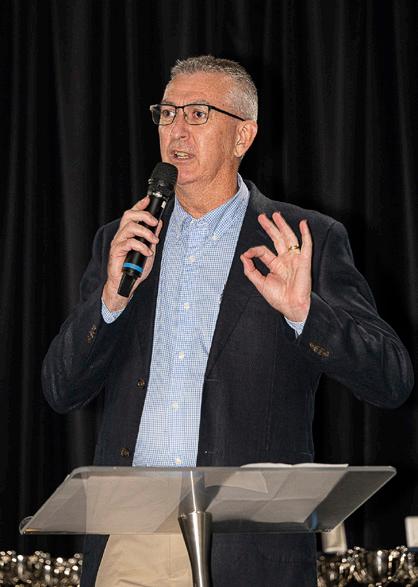



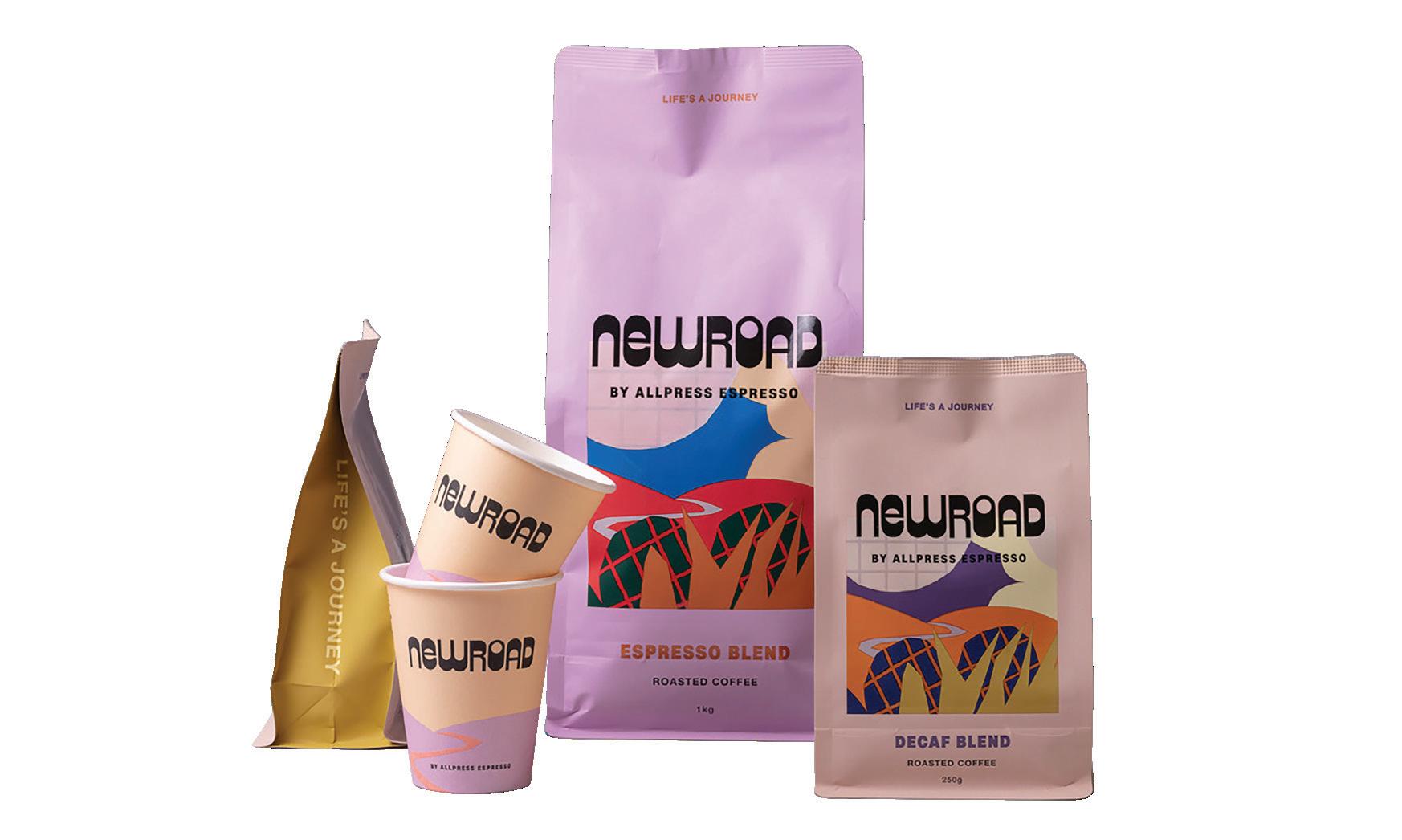

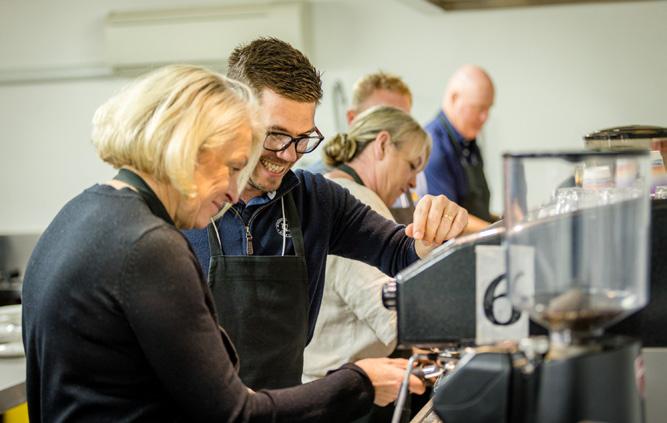
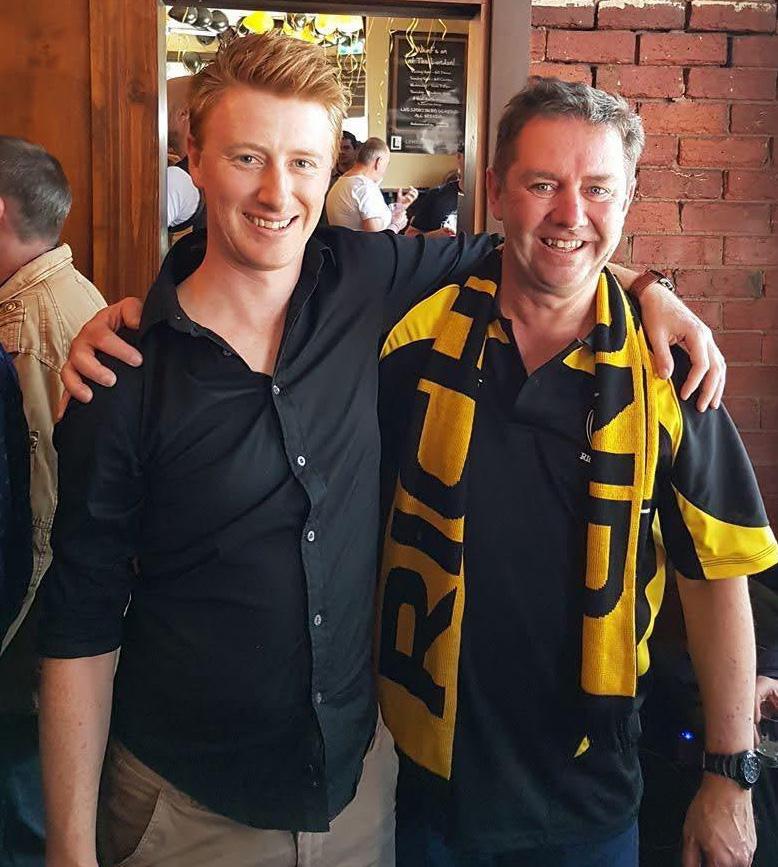











Golf Management Australia would like to sincerely thank all our valued partners for their ongoing support of GMA and our members.

MAJOR PARTNER of Golf Management Australia
PREMIER PARTNERS




NETWORKING PARTNERS




NATIONAL BUSINESS PARTNERS



ELITE PARTNER of Golf Management Australia





Winter has arrived, and with it, some unseasonal downpours – especially across Sydney and the Mid North Coast – causing significant disruption to golf.
Still, the game powers on, and the mood across the industry remains upbeat, with strong participation and plenty of optimism for the months ahead.
Many clubs are embarking on exciting capital projects and GMA is proud to present the upcoming Clubhouse, Land & Development Summit this August in Sydney. It’s the first event of its kind to bring managers and board directors together to focus squarely on capital investment.
We’ve assembled a top-tier line up of speakers and we’re confident the real value will come from the lively exchanges and shared experiences in between sessions.
Numbers are limited, so don’t leave it too late to secure your place.
In this edition, we feature a profile on Tony Rodgers and his extraordinary thirty-year tenure at Kogarah GC. If ever there were a masterclass in long-term capital planning, this is it – a true ‘War and Peace’ saga.
The story is rich in complexity, endurance and determination. We congratulate Tony on his legacy and wish him the very best for the next chapter.
Finally, we were deeply saddened by the recent passing of Anthony Dignan in late May, following a short battle with cancer.
I was fortunate to be in the Aussie contingent with Anthony to travel to the CMAA Conference in Tampa, Florida and like many, was shocked by his diagnosis. The outpouring of tributes is testament to the esteem in which he was held within the industry.
A proud supporter of GMA, Anthony rarely missed an event and relished the camaraderie of the network. Ben Russell has penned a heartfelt tribute to his mate, ‘Diggers’ – a much-loved figure who will be sorely missed.





NSW/ACT CHAPTER
Brenden Ellam
Castle Hill CC
Cameron Harvey Muirfield GC
Barry West
Mollymook GC
David Lulham
Nelson Bay GC
QLD CHAPTER
Aaron Muirhead
Oxley GC
Geoff Kuehner
The Brisbane GC
Gavin Lawrence Keperra CGC
David Marr
Pacific Harbour G&CC
Tim Gahan
Headland GC
SA/NT CHAPTER
Mark Tan
Royal Adelaide GC
Brett Lewis Kooyonga GC
Robert Vincekovic
Glenelg GC
Golf Management Australia (GMA) is a national body representing the golf club management industry with a vision of developing and supporting leaders in the profession of golf and club management in Australia.
GMA TEAM
Paul Vardy
Chief Executive Officer
Leigh Monti
Commercial Manager
Courtney Flores
NSW/ACT Manager, Program Manager
Mike Orloff
QLD Manager
David Brand
SA/NT Manager, Media/Communications
Rod Haines
VIC/TAS Manager, Finance Manager
Jodie Alaban WA Manager
Golf Management Australia Ltd. PO Box 859
CROYDON VIC 3136 www.golfmanagement.com.au
The GMA Journal is published by Golf Management Australia Ltd. © 2025 All Rights Reserved
Contents may not be reproduced without written permission.
Views expressed in editorial contributions do not necessarily reflect the opinions of this publication and it’s management.



VIC/TAS CHAPTER
Michael Burgess
Metropolitan GC
Barb Kelly
Chirnside Park CC
Mat Loughnane
Yarra Yarra GC
Chris Poulton
Spring Valley GC
Christian Tanner Riversdale GC
WA CHAPTER
Damien Todorovic
The WA GC
Des Shearer
Bunbury GC
Craig Ridge
Royal Perth GC


PAUL VARDY
It’s no overstatement to say the upcoming Clubhouse, Land and Development Summit in Sydney is one of the most timely and exciting gatherings GMA has hosted.
Across the country, clubs are re-imagining their facilities, whether through major renovations, new builds or exploring land use opportunities. The summit will offer a concentrated dose of knowledge, insights and shared experiences.
While no one claims to have all the answers, we’re bringing together an exceptional group of speakers who offer deep experience and spark the kind of conversations that matter, both from the stage and during the networking breaks.
Headlining is Joe Krenn CCM CCE of Farmington Country Club, supported by a dynamic mix of professionals in project planning, communications, feasibility analysis, finance, course architecture, stakeholder engagement and government relations, along with the essential perspectives of experienced GMs and board directors.
As part of the registration, we’re asking clubs to share what they’ve done, are doing, or are considering. The early responses give a good indication of the hot topics we’ll hear about:
» Clubhouse transformations – from major redevelopments and new hospitality spaces to modern pro shops and wellness facilities;
» Course and practice area upgrades –expanded driving ranges (often with simulators), improved short-game zones and substantial course works;
» Sustainability and technology – including automation, smart irrigation and energy innovations; and
» Land use and new income streams – such as aged care, mixed-use developments or activating underutilised land.
Whether you’re just starting out, already mid-project, or looking to share your experience post-completion, this summit is a unique opportunity to learn from others who are facing similar challenges and choices.
We look forward to seeing you in Sydney.
Golf Australia’s transition from GOLF Link to Golf Australia CONNECT has involved much communication in recent months between clubs and GMA. We appreciate the expertise of Michael Horton in reviewing the Use Agreement provided by Golf Australia.
Following a series of meetings, it remains to be seen whether a resolution can be found on the issues raised.
Have something to sell – or looking to buy?
A new community thread is now live on GMA Connect for peer-to-peer listings. It’s a simple way for clubs to connect, repurpose, or find what they need.
Check it out and join the conversation: connect.golfmanagement.com.au

Mark Boulton has announced his departure from Riverside GC in Tasmania to take up a much more important role: stay-at-home dad for his two beautiful children!
Monash GM, John Harrison, has announced his retirement, with Dan Paton to be appointed Acting GM whilst John takes some well-deserved leave prior to his departure.
Craig Jackes has been promoted from Assistant Manager to GM at Wyong GC.
After 3 years as GM, Fiza Errington departed Gosnells GC earlier this year, recently starting a club consultancy business, The Club Whisperer.
Busselton GC's GM, Ross Davis has taken up retirement whilst the club has also seen the departure of venue manager, Fenn McDonnell
Plenty of movement in Perth, with the departure of WA GC's venue manager, Dave Anderson, along with Royal Fremantle GC's venue manager, Nigel Cameron, who has moved to Cottesloe GC. Mt Lawley GC's F&B supervisor, Jack Cameron, has also moved clubs, taking up a new role at Joondalup Resort.
After 9 years, Gailes GC's GM, Frank McCarthy, has announced his retirement from the role.
Teven Valley GC's James King has fininshed his tenure as GM, heading back to live in Brisbane.
Wynnum GC GM, Bernard Wilson, has announced his departure from the club after four years.
Shaun Breheny has been appointed GM at Murwillumbah GC, moving from Byron Bay GC.
NSW/ACT Chapter
Flora Johnson - Balgowlah GC
Lauren McGill* - Killara GC
Christina Lucas - Tumut GC
QLD Chapter
Caitlin Hawkins* - Carbrook GC
Peter Hourigan - The Grand GC
Neville Hogan* - Pacific Harbour G&CC
Kerry Newsome**
SA/NT Chapter
Matilda Miels* - North Adelaide GC
VIC/TAS Chapter
John McKay - Yarra Bend GC
Fraser Bayne - Robinvale GC
Georgia Edwards* - Rosanna GC
Tim Dalton* - Settlers Run GC
Edward Nicolette* - Riversdale GC
Rajnesh Goundon - Mooroopna GC
Sasha Han - Moonah Links
Bronwyn Robbins* - Moonah Links
WA Chapter
Daniel Morland* - The Vines G&CC
Sarah Truwein* - The Vines G&CC
Christian Di Lodovico Pisani* - Lake Karrinyup
Brad White**
James Wilkinson**
^ Golf Facility members; * Provisional members; ** Former members


BEN RUSSELL • GENERAL MANAGER, LONG REEF GC
The recent passing of Anthony Dignan has left a deep void in the hearts of many across the golf and club management community.
It’s hard to believe that just in March, he was out on the course with many of us at the GMA golf day at Elanora CC. None of us knew he was unwell. Diagnosed just after Easter, he passed only six weeks later. The speed and shock of it all still hasn’t fully sunk in. Anthony was a character in every sense of the word. Whether it was a GMA conference, seminar, or golf day, Anthony was there bringing energy and a sense of camaraderie that made every event feel like a reunion. He was the guy who knew everyone, who made everyone feel known, and who could always be counted on to round up the “usuals” for a nightcap that often stretched into the early hours.
His career in club management included Portsea GC, North Ryde GC, Long Reef GC and Wyong GC. Prior to moving into club management, Anthony was a high school teacher on Sydney’s Northern Beaches and had also played 1st grade cricket for Manly and North Sydney and even a stint in the UK for Finchley in Middlesex, as well as football for the Sydney Swans under 19s.
On a personal note, I will always be thankful to Anthony for giving me my first job in club management at North Ryde GC and then the opportunity to join him at Long Reef GC a couple of years later. His guidance
had a profound impact on my career and is something I will never forget.
Whilst I'm grateful for the mentorship and guidance Anthony gave me over the past 10+ years, the shock of his sudden passing has made me sit back and think about his career, his values, his experiences, as that I noticed them.
Club management can be all-consuming. The hours are long, the demands constant, and the pressure unrelenting. But Anthony never let the job define him. His family always came first. He was at every basketball game for his daughter, every film screening for his son. He travelled widely, lived fully, and made memories that stretched from his mighty Richmond Tigers at the MCG on countless occasions to Tiger at Augusta in 2019.
At work, he was fiercely loyal to his team. He stood up for us in committee meetings, ensured proper communication channels were followed by board and members, and celebrated every milestone with a special occasion taking the team out. One of his traditions that I’ll never forget was the Friday 4:30pm office wrap up and drink to kick off the weekend. It was just one, but always enough to bring the team together and talk about life beyond the club.
What stood out most was Anthony’s genuine interest in people. The questions of uni subjects, weekend social activities, how your kids are doing or your pet’s latest antics and so on. He asked them and then took in
Anthony Dignan will be missed by the entire GMA community, but particularly those in NSW.
It was a shock to those who heard news in late April of his cancer diagnosis and even more so with his sudden passing on 23rd May. A small group of his NSW club management mates visited him in palliative care for a farewell and a beer on the day before.
The funeral service, held on Friday, 30th May in Manly, was a perfect autumn day. In the hour before, spotted everywhere were well-dressed people wearing yellow and black, the Richmond Tigers. Soon, the yellow and black army descended on St Mary’s Church where a service was held with close family and friends. Wonderful eulogies came from Anthony’s two
brothers about their little brother who loved life.
A kid from the 70s in Colac, Victoria, Anthony was an outdoor type who loved sport. The family moved to Sydney and Anthony played grade cricket for Manly and North Sydney against some of Australia’s biggest names. He played in the UK for Finchley in Middlesex, and played football for the Sydney Swans Under 19s.
A groomsman due at his brother’s wedding in the early afternoon, Anthony promised he’d be on time, making a quick fire 106 in the morning before honoring that promise.
From a GMA perspective, tributes to "Diggers" have flowed in. It is a reminder to us all to enjoy the camaraderie that comes from working in the golf industry and to value the friendships made.

every response. More impressively, I noticed the follow up questions and check in weeks and months later in passing with staff. It's very easy to get caught up in the craziness of club management life and forget about what is going on with each of your team, professionally and personally, however Anthony had a knack of being all over this.
Anthony’s legacy will live on in the people he mentored, the teams he built and the memories he made with his great mates through our industry. He brought out the best in others and left every club he touched better for his time there.
He will be deeply missed but never forgotten. Rest in peace Anthony, and thank you.
Anthony was a regular participant in GMA events. He was part of the original BMI group on the steps of The Lakes GC in 2018, attended PD days, golf days, state and national conferences.
Anthony won a scholarship to attend the CMAA World Conference in Tampa, Florida earlier this year and shared his experience in the autumn edition of this publication.
But most importantly, Anthony was one to share his attention, support the career journeys of others, and offer a friendly chat, a yarn and a beer.
Comments about Anthony, “A ripping fella; champion fellow; always up for a chat and a laugh; a great mate who lived large; one of the good guys; one of the nicest humans I’ve encountered.”
Vale Anthony Dignan, and thanks.
As the temperature drops, warm up your clubhouse with rich, full-bodied wines and award-winning fortified from our historic Rutherglen vineyard.

Contact De Bortoli to redeem a sample twin pack of Rutherglen wines to taste in venue with a representative
*one redemption per venue, offer ends 31//8/25





For all enquires contact your De Bortoli representative: Daniel Montagnese - 0419 138 905

GMA is proud to present a transformative professional development opportunity for members nationwide across the second half of 2025.
The Corporate Sherpa's Sarab Singh will headline the series with an insightful and detailed full-day of professional development for GMA members, covering the following topics:
Adaptive Leadership and Organisational Performance:
Equip yourself with strategies to navigate complexity, foster alignment and drive business outcomes amidst emerging challenges.
Psychology and Neuroscience of Performance and Engagement:
Discover science-based tools to enhance resilience, boost engagement and cultivate high-performance mindsets within your teams.
For those who attended GMA's inaugural education summit in Perth earlier this year, they will be familiar with Sarab's easy going, friendly and informative presentation style.
Sarab brings a wealth of experience as a human behaviour expert. With a unique blend of behavioural science and innovation, honed through participation in Harvard Business School's Executive Leadership Program on Innovation, he specializes in aligning business strategy with team performance.
Don't miss this opportunity to advance your leadership skills and connect with your fellow golf management professionals. Further information on each session, and when registration bookings open, will be communicated directly to chapter members in due course.
Want to know more about Sarab Singh and the Corporate Sherpas? Visit their website: www.corporate-sherpas.au
WA CHAPTER: University Club of WA Tuesday, 26th August 2025
VIC/TAS CHAPTER: Yarra Yarra GC Monday, 15th September 2025
SA/NT CHAPTER: Glenelg GC Tuesday, 16th September 2025
NSW/ACT CHAPTER: The Lakes GC
Wednesday, 17th September 2025
QLD CHAPTER: Nudgee GC Tuesday, 25th November 2025
GMA Members: $70 per person
Non Members: $99 per person
Cost includes all catering on the day.

ROD HAINES • OPERATIONS MANAGER (VIC/TAS)
The VIC/TAS chapter Committee Golf Day was hosted by the Commonwealth GC on Monday, 2nd June.
The event brings together golf managers and committee members for a day of golf, networking and celebrations. This year's edition was proudly supported by GMA's elite partner and strong industry supporter, Club Car.
The day began with a warm welcome, acknowledging special guests Joel Monahan and Andrew Bayliss from Club Car. Attendees were also welcomed on behalf of Commonwealth's club captain Ray McCann, president Wendy Nickson, general manager Peter Paccagnan, and superintendent Adam Lamb.
The format for the day was a Gentsomes teams event where the best drive is selected from the tee and players then play their own ball to complete the hole. The two best individual Stableford scores on each hole are recorded, with each player required to contribute at least three drives. Competitions included NTPs on holes 7, 9, and 15, and a longest drive on the 18th.
The evening’s formalities were led by Mat
Loughnane, general manager of Yarra Yarra GC. He emphasized the importance of the event in fostering relationships between managers and board members in a relaxed, social setting. He also highlighted the broader mission of GMA, which focuses on member development through educational forums and business events.
Special thanks were extended to the event’s corporate partners, including Club Car, Schweppes, MiClub, Acushnet, Pay As You Golf, Transform Golf Shop Specialists and The Golf Travel Agency.
A memorable moment came during the awards presentation when our very own CEO, Paul Vardy, representing the winning team, took the microphone. After graciously congratulating the other prize winners, Paul humorously admitted that he had expected his group to finish somewhere in the middle of the pack. Sensing from the audience’s reaction that his speech might not be landing as intended, he quickly wrapped things up and handed the microphone back to Mat, and earning a good-natured laugh from the crowd.
A special thanks to Commonwealth GC and its staff, especially GM, Peter Paccagnan, for their exceptional hospitality.
Congratulations to the winners of the individual competitions:
NTPs
» Hole 7: Josh Hall
» Hole 9: Rod Haines
» Hole 15: Chrissy Skinner
Longest Drive (Hole 18):
» Men: Kurtis Lynch
» Women: Chrissy Skinner
The team competition was fierce, with impressive scores across the board:
Winners:
Paul Vardy, Ryan Gallagher, Nick Arnold, Lachlan Kenny (108 points)
Runners Up: Chris Poulton, Steve Foulds, Kim Boehm, Adam Groom (104 points)
3rd Place: Rod Haines, Phil Wall, Chris Little, Kurtis Lynch (102 points)
4th Place: Josh Hall, Alanna Mills, Simon van Hammond, Raelene McDonald (99 points)

VIC/TAS CHAPTER
Lonsdale Links' Josh Hall has emerged as the unlikely champion of the 2024 Kelvin Quick matchplay trophy, capping off a long and dramatic event with a spectacular victory over Mitchell Grant in the final.
Hall, who entered the matchplay competition as the 16th and final qualifier, defied all expectations by eliminating some of the event's top contenders, including the no. 1 seed, Joe Sinnott, in a commanding 7&5 victory. The match, which showcased Hall’s precision and composure under pressure, set the tone for what would become a truly remarkable run.
From there, Hall's confidence soared as he dispatched qualifier 12, Mark "Cheeks" Lazenby, with a 4&2 win, and then overcame the formidable Andrew Noonan, qualifier 10, on his way to the final.
In a stunning display of skill and resilience, Hall faced Port Fairy GC's Mitchell Grant, the 8th qualifier, in what would be a thrilling conclusion to the event. Hall surged ahead early in the match, never letting up, and ultimately secured the victory with a 6&4 win, crowning him as the 2024 Kelvin Quick matchplay champion.
"I came into this event just hoping to make a solid run and maybe make a few upsets along the way," Hall said after his victory. "To
go all the way and win it is beyond anything I could have imagined. It's been a long and challenging event, but I’m incredibly proud of how I played."
The win is a remarkable achievement for the 43-year-old from Lonsdale Links, who had to navigate through some of the most difficult and talented players in the field. The Kelvin Quick matchplay trophy is one of the most prestigious events run by the VIC/TAS chapter, and Hall’s victory marks a major milestone in his golfing career.
Hall’s perseverance and focus were evident throughout the event, as he maintained a level of calm in crucial moments, turning what seemed like a distant dream into a reality. His triumph adds a new chapter to the history of Lonsdale Links, with Hall now joining the ranks of past champions who have etched their names into the event’s legacy.
As the final wrapped up, spectators and fellow competitors alike were quick to congratulate Hall on his incredible achievement. Mitchell Grant, who fought valiantly in the final, was gracious in defeat. "Josh was fantastic all day," Grant remarked. "He deserved this win. His consistency and composure were incredible."
For Hall, the 2024 Kelvin Quick matchplay trophy is not just a win; it's a testament to his growth as a player and his determination to contribute to the wonderful fraternity of GMA.
The GMA Member Assistance Program (MAP) is provided to GMA members and their immediate family through our service provider, Acacia EAP. Acacia EAP is a national independent service provider specialising in supporting people in dealing with personal or workrelated issues in a positive way.
Golf Management Australia offers its members the services of Michael Horton, from law firm RBHM Commercial Lawyers, in the role of Honorary Solicitor. The role is intended to enhance and assist general managers/GMA members in delivering a more valuable service to their golf clubs and boards.

AVAILABLE FOR PURCHASE
The GMA Green Book:
The Essential Guide to Strategic Planning for Golf Clubs
The GMA Green Book is produced by GMA with corporate specialist Tony Sernack.
Copies of can be obtained for $29.95 each (or $250.00 for a pack of 10).
To order your copy, please contact your Chapter operations manager. $29.95






SA/NT CHAPTER
DAVID BRAND • OPERATIONS MANAGER (SA/NT)
Westward Ho GC has finally broken their 25-year GMA Challenge drought, taking out the 2025 edition of the SA/NT chapter event, presented by Club Car, and played at Royal Adelaide GC in May.
Colin Anderson (GM) and Tony Taylor (captain), took out the trophy with a 4BBB score of 40 points in a tightly fought contest, on a countback from the home course team of Mark Tan (GM) and Sarah Chia (vice-captain), and the Aston Hills pairing of Brad Ashby (GM) and Neil Baulderstone (president).
The South Lakes combination of Chris Bailey (GM) and Richard Wood (board member), and The Vines team of Mark Crowe (operations manager) and Mick Gibbie (board member), both finished on 39 points to round out the top five positions in the challenge trophy.
The Acushnet team of Simon Gallie and Sean
Mahar took out the best score of the day with an impressive 41 points.
The victory by Westward Ho was even more significant, breaking the stranglehold that Mount Osmond GC has had on the event winning the last four consecutive events.
Mind you, as defending champions, Damien Wrigley (GM) and Nathan Gray (president), put up a good fight, finishing on 38 points along with the Tea Tree Gully pairing of Craig Sullivan-Brook (GM) and Neville Atkinson (president) in a tie for 6th place.
Early morning coffees and breakfast wraps gave players an opportunity to warm up in the clubhouse in front of the open fireplace before the early morning shotgun start, whilst a scrumptious 3-course lunch followed golf and provided all attendees the opportunity to network with each other and with the supporting partners on the day.
As is always the case, the hospitality provided by Royal Adelaide's team, and the presentation of the golf course, was
second to none. And, despite some very light showers throughout the day, the weather eventually proved to be typical for an Adelaide autumn day, making the walk around the world-renowned Seaton links an enjoyable one.
A special thanks to event partners, Club Car, and to Darryn Conway and the local team from Schweppes who continue to support each and every SA/NT chapter event. It was great to also have Paul Mullarvey and Peter McCarthy in attendance, representing Victor Insurance.
Thanks also Peter Shaw and the Golf Genius team for their assistance in managing the golf event scoring through their app, and to Simon Gallie and the team from Acushnet for supplying an impressive array of Titleist and Footjoy prizes.
Finally, thanks must go to Mark and his team, along with the Royal Adelaide GC board, for their continued support of this event. The club has been the traditional host for the GMA Challenge, and they have done so very generously since its introduction in 2000.

2025 BMI Food & Beverage attendees: (l-r) Courtney Flores (GMA), John Griffiths (Box Hill GC), Ingrid Morrison (Green Acres GC), Aaron Muirhead (Oxley GC), Liz Perkins (Perkins Coaching), James Woite (Box Hill GC), Catherine Williams (Elanora GC), Jessica Tedesco (Sun City CC), Ian Cottle (Burleigh GC), Teegan Negreira (Redcliffe GC), James Gold (Mount Osmond GC), Anna Fontaine (Glenelg GC), Kayla Milham (Metropolitan GC), Lisa Zahra (Lonsdale Links), Johnny Turnbull (Elanora CC), Elysia Yap (Royal Adelaide GC), Hamish Gilmour (Avondale GC), Josh Hall (Lonsdale Links), Duard Nel (Nelson Bay GC), Mark Stamopoulos (Warringah GC), Craig Stickling (NSW GC), Christian Di Lodovico Pisani (Lake Karrinyup CC), Adam Bryant (Glenelg GC), Tim Dalton (Settlers Run G&CC)
COURTNEY FLORES • NATIONAL PROGRAMS MANAGER
For the first time, Golf Management Australia took one of its BMI courses to South Australia and fittingly, it was the Food & Beverage component.
Held at the TAFE SA Regency Campus, the week-long program welcomed 22 attendees from across the country for an immersive, hands-on learning experience that blended education, networking and F&B.
The week kicked off with Financial Literacy 101, led by the ever-popular Liz Perkins. Attendees dove into best practices for food and beverage financials, including COGS, wage calculations and performance metrics.
The day continued with sessions on menu planning, service styles and operational controls, emphasising the importance of staff selection and training.
After a day of learning (and excellent food—Johnny was a happy man!), the group enjoyed a cocktail masterclass with TAFE's Mark Cranwell. The verdict? Real coffee makes a better Espresso Martini.
That evening, the group headed out for a social night at Holey Moley. Laughter echoed through the mini-golf course as friendly competition unfolded. The photo (right) with Elvis Presley summed up the night; fun, relaxed and full of personality.
Liz returned to guide discussions on food and beverage purchasing, followed by a



comprehensive session on staff and service management which covered recruitment, supervision, rostering and rewards. Before lunch, attendees were already deep into practical applications.
The afternoon featured fine dining table service training, where TAFE instructors demonstrated table setting, serving techniques and member satisfaction strategies. The day concluded with a discussion on event planning and community engagement, followed by a dinner where Liz (from New Zealand) tried kangaroo for the first time – which she loved!
Wednesday began with a session on club dining promotions, where Liz guided us through strategies to attract members through unique events and experiences. We explored the difference between hospitality and service and how to create memorable moments that keep members coming back.
The energy really picked up during our coffee workshop with Rosanna. Held in TAFE’s state-of-the-art training facility, the session was a highlight of the week. With eight commercial-grade coffee machines lined up in one room, each participant had the chance to get hands-on experience in a real café environment.
We learned how to properly grind beans, extract espresso shots and texture milk to create lattes, cappuccinos and flat whites. Rosanna walked us through the nuances of milk temperature, foam consistency and pouring techniques; skills that are essential for delivering a quality coffee experience in any club setting.
The afternoon shifted gears with a CVP (Cost-Volume-Profit) analysis session, our final one with Liz, where we explored breakeven points, profit planning and safety margins.
We wrapped up the day in the TAFE brewery, learning about the brewing process and sampling a variety of beer styles. It was a relaxed and engaging way to end a full day of learning.







For the final full day, we all jumped on a bus together as a group and went to TAFE's Barossa Valley campus in Nuriootpa.
TAFE's Paul Herbig introduced current food trends, sustainable practices and dietary considerations for menu development. Legal awareness in food and alcohol service was also covered.
Attendees then collaborated on function packages and menu designs with wine pairings, incorporating sustainability principles. The day concluded with a wine education session, exploring grape varieties and wine styles and, of course, some wine tasting!
We finished the day with a lively group dinner and a memorable bus ride back to Adelaide, complete with Christian on lead vocals.
Back at the TAFE SA Regency campus on Friday, we began with a session on brand and image, focusing on the importance of marketing and building a strong, lasting connection with members. We explored strategies for retaining membership and creating a club identity that resonates with the community.
The final activity was a powerful one: each attendee stood before the group and shared what had inspired them throughout the week. From practical takeaways to personal growth, everyone reflected on what they would take back to their clubs to implement and improve.
It was a moment of genuine insight and shared commitment to elevating the golf industry.



The BMI Food & Beverage course in South Australia was more than just an educational experience; it was a week of learning, connection and shared passion for hospitality within the golf industry.
From Espresso Martinis to wine tastings, from financial literacy to fine dining service, the week offered something for everyone.
If you’ve been considering attending a BMI course, we strongly encourage you to do so! It’s an invaluable opportunity to grow professionally and personally.
And if there’s one takeaway from the week? Italian and Indian foods do not mix!
For more information on the BMI Program, visit the GMA website: www.golfmanagement.com.au
When I first stepped into the golfing world seven years ago, I quietly set myself a goal: to one day become a general manager of a smaller club or the operations manager of a leading one. It was a long-term vision; something to pursue once my chapter in finance came to a close.
Beyond learning on the job, I committed to formalise my growth through professional development. My target? Earning certification through both Golf Management Australia (GMA) and the Club Management Association of America (CMAA), and
eventually achieving the coveted Certified Club Manager (CCM) title.
The CCM process is rigorous. It involves five intensive, week-long modules covering Food & Beverage, Leadership Principles, Club Management and CEO/GM responsibilities, concluding with a final review week and a demanding 700-question, four-hour exam. Along the way, it also requires ongoing participation in industry seminars, webinars and conferences, plus holding a relevant higher education qualification.
In March, I proudly completed my CMA accreditation and began the next phase: working towards my CCM.

Monday, 21st July to Friday, 25th July 2025
Riversdale GC, VIC
Monday, 8th September to Friday, 12th September 2025
Indooroopilly GC, QLD
When I joined my current club in June 2023, I was fortunate to receive the Women in Golf Leadership Scholarship, which helped me complete my first BMI module, Leadership Principles, at Latrobe GC. Recently, I tackled the Food & Beverage module in Adelaide, joining 21 other GMs, operations, and F&B managers.
The week, held at Adelaide TAFE’s hospitality campus, was intense: nine-hour days filled with expert-led sessions and hands-on practical challenges. The training opened our eyes, sparked confusion (in the best way) and left us energised with fresh ideas to elevate our club operations.
Coming from a finance background, I was the only one in the group from that field. Yet diving deep into discussions on cost of goods sold, wage cost efficiency, menu engineering and wine curation with top-tier hospitality leaders was incredibly enriching. It was also reassuring to learn that very few clubs turn a profit in F&B; only one out of the 21 represented clubs did. For most, the goal is simply to reduce the deficit or break even, recognising that hospitality is an extension of the golf experience, not a core revenue stream.
The week wasn't all work. Team-building events, from Holey Moley to a night in the Barossa Valley, proved invaluable. They fostered connections that now allow me to tap into a network of 21 industry peers for ideas, support and collaboration.
Next up? The BMI Club Management module at Riversdale GC in July. If all goes to plan, I hope to earn my CCM by mid-2026 and join an elite group—currently only seven managers in Australia hold this certification.
This journey is far from over, but every step brings me closer to the vision I set years ago. And I’m loving the challenge.
REVIEW WEEK & CCM EXAM
Sunday, 23rd November to Friday, 28th November 2025
Venue TBC
For more information on the BMI Program, visit the BMI page on the GMA website: www.golfmanagement.com.au
Golf Management Australia (GMA) is pleased to announce a new corporate partnership with Good Drinks Australia, joining as a networking partner from 1st July 2025.
As one of Australia’s largest independent beverage companies, Good Drinks Australia (GDA) is best known for its popular brands like Gage Roads Brew Co, Matso’s, Ably, Coors, Magners Cider and Rekorderlig. As the county's fastest growing beer and cider supplier, GDA is well positioned to support GMA members in enhancing their beverage offerings and on-premise operations.
GMA CEO Paul Vardy said the partnership reflects growing interest among clubs to refresh and evolve their member and guest experience. “Good Drinks really understands the licensed venue space and how to bring a modern, flexible approach to beverage partnerships. For our members, this is an
opportunity to tap into that experience and explore new ways of adding value to their hospitality operations,” he said.
Head of On Premise at Good Drinks, James Whiteford, echoed that sentiment, explaining that the golf industry is a natural fit for their team. “Golf clubs are great social venues with loyal member bases. We see real opportunity to help clubs build a better beverage experience, whether that’s through quality tap offerings, more variety or supporting club events,” he said.
GMA members will benefit from a range of tailored services through the partnership, including product supply, promotional support and opportunities to collaborate on venue activations and engagement strategies. Importantly, clubs can expect a personalised approach.
Leading the relationship on behalf of GDA is Dan Moraday, Head of Events and Partnerships, who says he’s looking
forward to working directly with GMA clubs. “We’re not here to push a one-size-fits-all model. Our aim is to work with each club to find what fits their goals. That could be through growing bar revenue, running branded events or simply offering members something new,” Moraday said.
The new partnership supports GMA’s commitment to connecting its members with industry-leading suppliers who offer practical, relevant support to clubs of all sizes.
For further details on how GDA can support your club, please contact James Whiteford: M: 0407 417 137 W: www.gooddrinks.com.au




Golf Management Australia (GMA) welcomes new networking partner Shield Training & Consulting to our growing portfolio of corporate relationships, commencing from 1st July 2025.
Shield Training is the only provider in Australia dedicated exclusively to helping golf clubs prepare for medical emergencies, particularly sudden cardiac arrest.
With a team of experienced intensive care paramedics, Shield offers golf club-specific training and support services that reflect the unique risks of medical incidents on golf courses, where access is often difficult and emergency response times can be delayed. Services available to clubs include CPR and defibrillator training for staff and volunteers, critical incident response planning, emergency signage and access assessments, on-course drills and simulations, and postincident debriefing.
Shield’s work is grounded in real-world emergency experience and a strong understanding of the club environment.
Sydney’s Cromer GC is one facility which has already experienced the benefits of the services provided by Shield. General manager, Melissa Ellis, explains, “Shield Training has transformed our club’s approach to emergency medical preparedness. Their customised training for golf course safety has not only elevated our team’s confidence in handling medical situations but also reinforced our commitment to member and guest safety.” Ellis believes Shield’s expertise is unmatched and wholeheartedly recommends them to any club prioritizing member safety and professionalism.
GMA’s CEO, Paul Vardy, welcomed the partnership, saying, "Shield Training addresses a unique and critical area of risk in golf clubs – medical emergencies on the golf course. Their targeted and practical approach offers valuable support and insight to our members, many of whom are seeking ways to enhance safety and preparedness at their facilities."
Michael Covey, Shield’s Managing Director, said the partnership will help extend their impact across the club network. "We are
proud to partner with GMA and support clubs in strengthening their emergency response capabilities. Our mission is to help save lives on golf courses, and through this partnership, we can reach more clubs and help ensure they are equipped to act decisively in the critical first minutes of a medical incident."
This new partnership with Shield Training reflects GMA’s commitment to delivering access to trusted, practical resources that support the safety, professionalism and operational excellence of its members and their clubs.
For more information about Shield Training & Consulting, contact managing director, Michael Covey:
M: 0419 433 993
W: www.shieldtraining.com.au
»
»
»
»
Part

Golf clubs and facilities are highly capital-intensive businesses with large areas of land, clubhouses, maintenance sheds, plant and equipment.
A recent survey of GMA members found that around 60% were planning to add new capital facilities in the next five years. Many more will be renovating existing facilities.
Golf is thriving and many clubs and facilities are asking themselves the question, what are current trends and what is possible with future upgrades and use of available space that will propel our venue forward.
Sydney 2025 - the Clubhouse, Land & Development Summit - is set to be the golf industry's unmissable event of 2025, to be held at Pier One Sydney Harbour from 12th to 14th August.
Headlined by the CEO/GM of Farmington Country Club, VA, USA, Mr Joe Krenn, the summit is a two-day conference that will present critically important steps in arriving at the right decisions on capital projects, with the right team and with the right processes for success.
Delivered by Golf Management Australia (GMA), Australia’s peak golf management body, the summit will attract key decision makers in clubs and facilities, to learn from experts, share best practice, strategies and stories, and identify opportunities to maximise the use of important golf assets.
Sydney 2025 is brought to us by our major partner, Schweppes.
Sydney 2025 will connect leaders of golf clubs and facilities, golf industry experts, consultants in planning and project development, product providers, and experts in building, renovating and developing sites.
Hear directly from industry leaders, developers and experienced managers about the challenges and lessons from capital planning projects.
Gain practical insights into funding models, feasibility analysis, member consultation, and navigating council and planning approvals for major developments.
NETWORK
Connect with 150 peers, experts in projects and consultants, and understand different approaches across clubs.
Strengthen your strategic thinking, planning confidence, and decision-making capability to lead capital works projects from concept to delivery.


TUESDAY, 12TH AUGUST
6:00pm Welcome cocktail party reception Pier One Sydney Harbour
WEDNESDAY, 13TH AUGUST
8:15am Arrival
8:30am Summit welcome & introduction
8:40am Capital projects in clubs
9:00am 10 key metrics on the path to capital planning
9:45am The importance of vision and positioning for future member experience
10:30am Morning tea & networking
11:00am Creating an effective & efficient project management team
11:55am Case Study/Panel discussion
12:45pm Lunch & networking
1:45pm Funding capital improvements
2:30pm Risk & insurance considerations before you lock in
3:00pm Afternoon tea & networking
3:30pm Construction feasibility & valuation - project cost estimation & ROI
5:00pm Education sessions close
6:00pm Summit networking dinner InterContinental, Sydney
THURSDAY, 14TH AUGUST
8:15am Arrival
8:30am Welcome & opening
8:35am Construction costs & project administration,and specifications, contracts & scheduling
9:15am Options with use of land in community living
9:50am Golf construction for use of land, case studies & examples
10:30am Morning tea & networking
11:00am Detailed feasibility studies & navigating, partnering & working with government agencies & stakeholders
12:00pm Case Study/Panel discussion
1:00pm Lunch & networking
2:00pm Construction scheduling & project controls
3:00pm Afternoon tea & networking
3:30pm Wrap up panel & discussions
4:30pm Education sessions close
NB: Program is under development and subject to change.
Once final details have been confirmed, an updated program and a full line up of presenters will be published on the GMA website and sent to all delegates in the lead up to the event.
Sydney 2025 will be an educational event focused on capital improvements and ideas for the use of land, covering topics including:
• Building effective project teams;
• Master planning for facilities;
• Gaining member support for projects;
• Strategy development for capital improvements;
• Construction feasibility and costing;
• Assembling construction teams;
• Capital improvement funding options;
• Legal and insurance essentials;
• Innovative land use opportunities;
• Driving ranges;
• Technology-enabled hybrid spaces;
• Mini-golf;
• Integrated community living spaces;
• Construction contracts and project administration;
• Navigating government approvals;
• Construction scheduling and project controls.

Pier One Sydney Harbour 11 Hickson Rd, Dawes Point
Pier One Sydney Harbour, Autograph Collection, enjoys a prime waterfront location at Dawes Point, directly under the Sydney Harbour Bridge and within walking distance of The Rocks, Circular Quay, and the Sydney Opera House.
Set in a heritage-listed Federation-style wharf building, the hotel offers a unique blend of historic charm and contemporary style with sweeping views over Sydney Harbour and Luna Park enhancing its appeal.
www.pieronesydneyharbour.com.au
Across Australia, many golf clubs are facing a familiar crossroads: ageing facilities, rising operational costs, and valuable land with untapped potential.
While development can unlock capital and drive club renewal, it’s not just about what gets built it’s about how the process protects and enhances the club’s identity, governance, and long-term relevance.

Faced with increasing operational costs, Cumberland Country Golf Club partnered with Pariter to unlock land value, while preserving its 18-hole golf course. The outcome:
• A medium-density, architecturally sensitive retirement community designed around the club’s ethos.
• Enhanced member amenities and improved financial stability.
• A future-proofed club brand and a broader community connection − achieved without sacrificing tradition.
At Pariter, we believe that the most successful projects aren’t developer-led, they’re club-led. And the goal isn’t a building, it’s a legacy.
Development as a Strategy, Not Just a Project
Land development offers golf clubs more than just one-time capital. With the right partner, clubs can:
• Shape the future of their land and facilities
• Retain brand identity and club culture
• Generate recurring revenue streams to support long-term sustainability
• Strengthen community relevance through integrated living and renewed patronage
Principles of a Community-First Partnership
At Pariter, our partnerships focus on:
• Respecting the past: Co-branded solutions that retain the club’s identity and autonomy.

• Planning for relevance: new members, activate underused land, and foster intergenerational connection.
• Ensuring ongoing club involvement: Governance models where clubs remain active stewards of their future.
Building Trust and Managing Stakeholders
Gaining member and community support requires more than financial rationale. It demands trust, transparency, and shared vision.
Our approach includes:
• Early co-design with Boards and members
• Staged, transparent communications throughout planning
• Brand stewardship, ensuring the Club’s story remains central throughout the development journey.
Common concerns such as land loss, brand dilution, and operational disruption can be mitigated through:
• Joint governance structures
• Brand-aligned design and placemaking
• Clear frameworks for long-term stewardship of both the project and club assets.
Success is a Living Legacy
A successful development delivers:
• A vibrant, sustainable club
• An engaged community of members, residents, and visitors
• Enhanced financial resilience
• A club legacy that is not built over but built upon.
If your club is thinking about the future, and how to protect what makes it special, we’d love to connect. Visit us at the upcoming GMA Summit to explore how a community-first development partnership with Pariter could unlock long-term value, relevance, and resilience for your club. LET’S START A CONVERSATION ABOUT BUILDING NOT JUST FACILITIES, BUT A FUTURE YOUR MEMBERS WILL BE PROUD OF.

Registration includes:
• Tuesday Welcome Cocktail Party
• Wednesday Networking Dinner
• All education sessions on Wednesday & Thursday
GMA Members: $950pp Non-Members: $1,750pp
All prices listed include GST.
Registration includes:
• Tuesday Welcome Cocktail Party
• Wednesday education sessions
GMA Members: $500pp Non-Members: $900pp
Registration includes:
• Wednesday Networking Dinner
• Thursday education sessions
GMA Members: $550pp Non-Members: $950pp
Member Price - applies for club board/committee members and any club staff attending with a GMA member. Non-Member Price - limited places available, on GMA approval only.
Should a delegate be required to cancel their registration before COB Friday, 1st August 2025, a full refund will be provided to the delegate after the conclusion of the event. For any cancellations on or after this date, refunds may only be provided at the sole discretion of the GMA Board, and no refund guarantees are made.
Should the event be cancelled as a result of government legislated restrictions, all registration fees will be refunded in full to delegates. This cancellation policy is subject to change at any time.
With more than 1,400 discussion threads and 126 uploaded items in the library, GMA members are engaging with GMA Connect to share questions, knowledge and resources.
Join the conversation – share with your colleagues, or simply read the threads and stay informed. Thanks for your contribution.
GMA members can go to connect.golfmanagement.com.au and use your GMA sign-in and password to join in the conversations.

In 1994 a young Tony Rodgers was new to being a general manager of a golf club but filled with enthusiasm, determination and a desire to help build the club to its potential.
Thirty-something years later, he has been thoroughly tested but has given his all to see his beloved club through to a future it might not otherwise have had.
Regular GMA Journal contributor, Karen Harding, explains.
When a young Tony Rodgers walked into Kogarah Golf Club, 14 kilometres southwest of the Sydney CBD, in 1994, he was certainly not untried, but was yet largely unproven. Thirty and a bit years later, he has nothing to prove to anyone.
It is impossible within the scale of this piece to fully describe the process that started with a preliminary conversation on November 6, 1996 and concluded with Kogarah’s official amalgamation with Liverpool Golf Club to become Oak Point on July 1, 2024. On March 31, 2025 this year, the gates closed on the Kogarah golf course and on May 2, Rodgers completed his commitment to Kogarah and to Oak Point. Suffice to say It’s been quite the journey for the man at the centre of it throughout.
I've
had a ride, yes
“I’ve had a ride, yes,” is his succinct summation. An understatement, definitely.
With a degree in Applied Science (Materials) - Metallurgy, Organic Chemistry, Ceramic Engineering, Rodgers might on face value have seemed an unlikely choice for a General Manager position at an established and storied metropolitan club. But he did have nearly nine years experience working in an RSL club, so there was that. He decided to apply.
“I was always looking to move forward, take on a challenge, and as I was part of managing an RSL club and a golfer, it sounded like a good idea. I certainly didn’t go there thinking I would be there for 30-plus years. I got in, did all the normal things, there was a lot of learning needed, but it was all interesting stuff and while I wasn’t fully across it, I was familiar with most aspects. My early thoughts were that it was a great club with great potential but we really needed to do a few things.”
The club by 1994 was 66 years old, having been founded in 1928. Ironically, it had

land issues from the start when the originally planned site proved untenable and it was decided to construct nine holes within the Moorefield Racecourse. Under the auspices of the much respected Dan Soutar, winner of the 1903 Australian Amateur, the 1905 Australian Open and designer of Kingston Heath, the links opened for play on Good Friday March 29, 1929.
In a piece penned for the St George Historical Society some 50 years later, foundation member Miss Frances Stacey recalled the site as being picturesque and while “the land to be used was inside the Race Course …. some of the tees were placed beyond and above the race track.
It didn’t really occur to me to give up. While pragmatic I may be, stubborn I definitely am, and even more loyal. Kogarah Golf Club provided me with so much. I wanted a great outcome for them and they trusted me to deliver. I made myself responsible for delivering that outcome for members and staff.

This caused a real hazard … as so often the ball would hit a fence or become lost among the hoof marks (some very deep) of the horses.
“The Members of the Golf Club had the use of most of the Members Stand at the Race Course. The lovely verandah on the President Avenue side … (was) surrounded and shaded by the lovely old Moreton Bay Figs, which must have been a great age then.”
This idyllic picture was somewhat shattered in 1955 when its land was sold for school and housing purposes but the club regrouped to move to its longtime site in Arncliffe.
Approximately 18Ha was purchased from the Federal Government and the rest leased from various other government bodies including Rockdale Council (now Bayside). This arrangement secured its immediate future but unfortunately also laid the foundation for later difficulties with half the site not only owned by multiple bodies but also being an odd wedge-shaped parcel with Cooks River to the east and Marsh Street – initially a dead end street and now a six-lane road leading to Sydney Airport – to the north.
In his early days at the club, this was not Rodgers’ focus, though it would soon become so.
“At that stage I was trying to get them
to look at four-year, five-year, plans and say, well, where do we want to head, what do we want to do? But that didn’t last long. Within two years we were being approached on a number of matters.”
As a marker in time, “November 6, 1996 is a date I’ll never forget.”
On this day, representatives from Rockdale Council, Sydney Airport and then local member of State Government George Thomson met with then Kogarah GC President Tony Rice and Rodgers to discuss what would be known as Project A, the precursor to the Cooks Cove development project.
The thrust of Project A was for the club’s

land to be sold for a Darling Harbour style development and the club to be relocated to an area south of its existing site with the security of a 99-year lease.
“That was a very important opportunity presented to us on that day. And from there on, our focus was on how did we make this work for our club.”
With hindsight and his penchant for understatement, Rodgers reflects: “I guess it was probably a little more fraught than I probably gave consideration.”
Indeed it was. From here, progress took any number of twists, turns and stumbles as bureaucracy and multiple competing interests jousted over the next 13 years. In all that time, as individuals and organisations changed over and over, Rodgers remained central to the process, exposing him to compounding stresses.
Did he considered moving away from it?
“It didn’t really occur to me to give up. While pragmatic I may be, stubborn
“I definitely am, and even more loyal. Kogarah Golf Club provided me with so much. I wanted a great outcome for them and they trusted me to deliver. I made myself responsible for delivering that outcome for members and staff.”
By 2002, with an agreement with developers settled, various agreements with government in place, design concepts drawn, financial arrangements addressed and the all-important 99-year lease assured, the club was able to take the proposition to the members. It met with 81% approval, strong vindication. By 2006 a Master Plan Development Application was organised and in 2007, approved.
Then, the GFC.
“The GFC ultimately stopped us, rightly or wrongly. We were well and truly underway and I think had we gone another six, eight, ten months before the GFC hit, we would probably have managed to achieve the relocation.”
On April 4, 2009, after a critical meeting
The GFC ultimately stopped us, rightly or wrongly. We were well and truly underway and I think had we gone another six, eight, 10 months before the GFC hit, we would probably have managed to achieve the relocation.
with financial backers, it became apparent that fallout from the GFC had put a handbrake on the project. Discussions nonetheless continued with the state government and building and development companies even as community opposition to the club’s relocation to adjacent public land was mounting.
To add to these stresses faced, there were still everyday matters to which to attend and other significant works to be accommodated. Included, for example, were the no small items of construction of high pressure gas and desalinated water delivery pipelines and roadworks related to the WestConnex motorway that reduced the course to 15 holes from 2016.
By 2022: “We all knew we had run down all of our development options, due to the building opposition and government agendas that had moved on, and we would not be moving next door.”
Ever the pragmatist, Rodgers’ thoughts turned to viable solutions, merger with
“To be able to do the things I’ve been able to do and be involved in the things I’ve been involved in, I’ve been constantly stimulated. I’ve really, really enjoyed it. But at the same time, you are often on your own.
another club included. Liverpool Golf Club, around 30 minutes west of Kogarah and with different but pressing issues of its own, proved to be a viable choice. And so, two years after the ultimate disappointing end to the Cooks Cove proposal and some 28 years after the 1996 meeting, amalgamation with Liverpool was completed and the new entity Oak Point Golf Club emerged. Rodgers remained through handover and the appointment of Robin Taylor as the GM of Oak Point. The choice to leave was his own. While there were many factors in his decision, it is clear that he was exhausted, not just from the length of the process but the breadth of what was involved.
“Exhaustion is one of those funny things that I’m not sure you recognise what it is. I think I probably worked a couple of lifetimes of employment over that 30 years. But every manager works a pretty long week. And it’s such a stimulating environment, it’s family, so it’s work but it’s not work. While I was going through it, I felt pretty good. I don’t think I got physically tired, I got mentally and emotionally tired. And that’s what stops you.”
It's still early days for Rodgers to commit to what’s next but he is able to reflect on
highlights from his tenure at Kogarah, support from the GMA community, and homework for other managers as they approach the upcoming GMA summit on Clubhouse, Land and Development to be held at Pier One Sydney Harbour from August 12-14.
“To be able to do the things I’ve been able to do and be involved in the things I’ve been involved in, I’ve been constantly stimulated. I’ve really, really enjoyed it. But at the same time, you are often on your own.
“For a time, because this went for so long, I think I isolated myself a bit from the GMA group so to not be talking about what was happening. But then things changed and I felt I could just come back into the group and just be with good friends who understood what we went through on a daily basis. That support is absolutely invaluable.
“But when I think of what kept me there, I keep going back to the support of the members. My relationship with the members has been extraordinary, I’ve had wonderful members. When I think of the ruckus we could have had but didn’t…. And on equal footing, my team. I had nine on my team that had been with me 20 years or more. So, yeah, members and team, they’re the standouts for me.”

Northstar’s fully integrated F&B solutions are designed specifically for clubs, helping streamline operations, drive revenue, and elevate the dining experience.






Empower staff to take orders and process payments at the table for faster, more personalised service.
Manage table flow, reservations, and pacing with a dynamic floor management tool.
Let members browse the menu, order, and transact from their phone, ideal for self-serve areas, terraces, or when convenience matters most.

Digitise your kitchen workflow with real-time order tracking and improved communication between front and back of house.
Offer takeaway convenience with advance ordering and quick pick-up, perfect for members on the move.
Tracks member order history and instantly displays their favourite dishes or drinks to the server for personalised, efficient service.


“It was at times very testing, at times very sad and disappointing. But it was compelling. It's been like a novel that I couldn't put down, you know, I needed to get to the end. Would I do it again? Knowing now what was to come, yes, I would, because strangely I've enjoyed it immensely.
This is said with controlled but considerable emotion, evidence of the strong bond between all GMs and their flock, as well as the still present emotional fatigue and grief of this good shepherd.
What of regret or disappointment?
“I am quite pragmatic and realised very early that for the Club to achieve its goal of relocation, many approvals were required. Even though we had strong support at state and local government level, there were still many things needing to go the right way. I think had the GFC not occurred or had occurred a year later, we probably would have succeeded.
“That we didn’t get to relocate next door will long be a disappointment as it would have been tremendous, it would have changed the club. We would have been in a position to be in the upper echelon of Sydney golf and that would have been a really remarkable outcome and a great achievement.”
While Rodgers ponders what next, what happened at Kogarah is a potential lesson for others.
“Post-Covid, many clubs are still riding the crest of the wave but things will change, they always do. The pressures on limited land resources will continue to grow and increasingly will be felt by golf clubs as they justify their privileged members only or mainly members use of the land. Clubs must be prepared to consider change and give thought to what the best outcomes may be from the options available before the ability to choose is lost. Negotiation at a time of desperation will not yield the best outcomes.”
Rodgers’ learnings are plenty and worth heeding:
» Understand the risks, potential and real, that the club faces.
» Develop prioritised strategies to address those risks.
» Be proactive in dealing with the local council and any lessors.
» Value and engage with your members and staff.

» Promote your club’s value to the community.
» Start discussions early.
» Beware of short-term fixes. A longer view will usually be more fulfilling.
» Engage good representation/advice.
» Understand your asset’s value to your club, the better resourced club or to potential developers, as the case may be.
» Ensure the potential 'winners' pay the bills.
» Do not be in a hurry to sell land parcels for a quick cash boost. Consider the longer-term value to be realised.
» If building a new clubhouse, ensure the business case for the design stacks up.
The plight of Kogarah, according to Rodgers, was unique, not in having issues – those are present in every club – but in terms of the number of issues it faced, often concurrently. It’s a cautionary tale.
It’s also an exceptional story on many levels.
Asked how he would describe the story, Rodgers answered, first flippantly; “a
mess!” and then more seriously: “Looking back, if you had a manager that you'd like to play the biggest practical joke on and you said, I'm going to stitch you up for the next 30 years with trials and tribulations, I don't think you could have got the combination that we've managed to have to work through.
“It was at times very testing, at times very sad and disappointing. But it was compelling. It's been like a novel that I couldn't put down, you know, I needed to get to the end. Would I do it again?
Knowing now what was to come, yes, I would, because strangely I've enjoyed it immensely.
“There's been some personal cost involved for me and my family in terms of the time that it’s taken up and it’s been a huge burden on the members and everyone involved but we’ve taken the club from something that could have disappeared to something that will go on to do good things in golf for a long time to come.
“In the end we didn’t find the pot of gold but that wasn’t for a want of trying. And the amalgamation, while not the ideal, is a very good outcome.”
PAUL MULLARVEY • VICTOR INSURANCE
Storms always have and will pose a large threat to insurance programs. That threat can be double for golf clubs with the asset exposures of both clubhouse and golf course.
Golf clubs don’t have the ability to control what happens in the skies above their course, however they do have a large degree of control about what happens on the ground.
The fundamental of property insurance is to return the insured asset to the state it was before it was damaged by an insured event. But what if the state of a roof, before the storm, has broken tiles or blocked and rusted box guttering? If a storm hits a roof in such a condition, is the storm the proximal cause of the damage?
There have been storm damage claims denied because the roofing had pre-existing problems with hail and rainwater entering the building through openings not created by the storm itself.
Golf clubs need to be careful that they don’t place themselves in a position where a storm
damage claim is questioned due to the possibility of pre-existing roof or drainage condition. Given no general manager wants to add a damaged roof / closing a section of the clubhouse / insurance claim process to their list of jobs, a logged maintenance program that includes the regular cleaning of gutter and drainage systems and annual roof and drainage inspections by qualified service personnel is not only a great preventative measure, but it also provides support to any required insurance claim.
After a 2024 storm event in which a golf club suffered extensive water ingress damage to the clubhouse, the loss adjustor working on
Victor Insurance Pty Ltd (“Victor Insurance”) is an underwriting agency and an authorised representative (AR No. 403803) of Marsh Pty Ltd (ABN 86 004 651 512, AFSL 238983) (“Marsh”).
This publication contains general information, does not take into account your individual objectives, financial situation or needs and may not suit your personal circumstances. For full details of the terms, conditions and limitations of the covers and before making any decision about whether to acquire a product, refer to the specific policy wordings and/or Product Disclosure Statements available from Victor Insurance on request. Victor Insurance makes no representation or warranty concerning the application of policy wordings or the financial condition or solvency of insurers or re-insurers. Victor Insurance makes no assurances regarding the availability, cost, or terms of insurance coverage.
Victor Insurance are partnering with Golf Management Australia (“GMA”) and Golf Australia to educate golf clubs on the need to consider insurance in a broader context. © 2025 Victor Insurance Pty Ltd. All rights reserved.









Toro Australia, a leader in sports turf equipment and irrigation solutions, is proud to announce its exclusive partnership with TerraRad to distribute TurfRad, an innovative turf management system that revolutionizes precision turf care.
This collaboration combines Toro’s decades of expertise in irrigation and turf maintenance with TerraRad’s advanced sensor technology, offering groundskeepers and turf professionals an unparalleled solution for optimizing playing surfaces.
“At Toro, we are dedicated to delivering the most advanced turf management solutions,” says Hamish Lloyd, Irrigation Product Marketing Manager at Toro Australia.
“Through our exclusive distribution of TurfRad, we are integrating cutting-edge technology with our industry-leading
equipment and irrigation systems, ensuring turf professionals have the best tools at their disposal.”
The TurfRad software relies on smart sensors installed on Toro equipment to map soil moisture levels while you mow or traverse the grounds. The sensors are able to measure subsurface moisture up to 10 cm deep, even through thick vegetation, and provide continuous readings for complete mapping of the grounds.
The sensors will send the data to the software in real-time, providing colourcoded maps that indicate soil moisture variations across the entire course, whilst also providing moisture uniformity and average moisture around each individual sprinkler head. TurfRad allows complete visualization of the grounds soil moisture to help improve playing conditions, save water and optimize application of wetting agents.

For more information on Toro Australia's partnership with TerraRad, or any other products and services offered, contact Toro Australia's customer service:
P: 1300 130 898
E: irrigationau@toro.com
Follow @ToroAustralia on:
PAUL VARDY • CHIEF EXECUTIVE OFFICER
Spending time with General Managers and CEOs from some of the most prestigious private clubs in the US offers fascinating insights into what they see as critical to their success.
At first glance, a club tour is all about the wow factor—the incredible facilities, the impressive amenities and the seamless hospitality. Quite simply, hospitality runs deep in their culture.
But beneath the surface, the real story quickly emerges. It’s not just about the buildings, it’s about the people. Every conversation, every example, reinforces one thing: everything starts with the team.
Here are some key takeaways that translate well to the Australian club environment.
Hiring the best talent is only half the battle; keeping them is the real game. US GMs are laser-focused on retention rates and often cite them as a key performance metric. They proudly talk about the longevity of staff— where individuals started and how they’ve grown within the club. Retention isn’t just a number, it’s a badge of honour.
Language matters. Across the board, employees are referred to as the 'team', not 'staff'.
It’s a deliberate choice that reflects the investment in culture and training. Clubs focus on regular 'all-team' gatherings, offer high-quality meals in dedicated team dining areas and ensure every team member feels valued and acknowledged. This isn’t just a gesture, it’s embedded in their operating model.
Service excellence is non-negotiable, and that includes managing wait times. Whether it’s food service or valet parking, speed matters.
At an International Symposium, Jim James from Augusta National shared that during the US Masters, the seven restaurants at Berckmans Place (with 1,800 seats) operate with the goal of delivering orders within four minutes; a standard that’s closely monitored.
Even beyond food, wait times are a priority. Watching the valet team during a major event was remarkable, with young attendants sprinting (not walking) to collect cars, keeping wait times to near zero.
Clubs are constantly evolving. A typical day for members might start with a gym session, followed by padel or pickleball in the afternoon, and dinner at the club in the evening.

Many clubs are undertaking continuous upgrades of their clubhouses, golf courses, pools and wellness centres, even when existing facilities would be considered first-class by most standards. In some cases, buildings only a few decades old are torn down in favour of state-of-theart replacements. Members, often paying initiation fees of US$250,000 or more, appear willing to support this through substantial capital levies.
In places like Florida, where 90% of club activity happens within eight months of the year (outside the storm-prone summer), keeping amenities current is critical to competitiveness.
Yes, members are at the heart of the club, but behaviour shapes culture. One thing that stood out during club visits was the simple civility of members. Clubs don’t tolerate poor behaviour. Issues are addressed swiftly, preventing them from becoming entrenched.
A recent documentary aired ahead of the 125th US Open at Oakmont CC, focusing on the club’s restoration by Gil Hanse. But an interview with Bob Ford, Oakmont’s PGA head professional for 37 years, was equally revealing.
Bob, who has worked numerous US Opens and was the starter in the 2025 event, was asked what makes a good member. His response was simple and powerful:
“Be supportive of the club you’re a member of. Be supportive of the staff. And be great to the staff. If you step over the line with someone on the staff, you’re gone.”
This philosophy is clear: culture isn’t negotiable. Respect for the team is an expectation, not an aspiration.
While the scale and financial models of US clubs can be different, the fundamentals resonate strongly.
Whether it’s nurturing a high-performing team, refining service standards or fostering a strong culture, the lessons are highly applicable.
At the end of the day, it’s a reminder that world-class facilities are impressive, but world-class teams and cultures are what truly set great clubs apart.
The recent GBAS Governance Forum challenged traditional club structures, with presenter Colin Carter suggesting CEOs should sit on boards. In this Q&A, we ask The National GC's Matthew Corby how this model works in practice and why more clubs may follow.
The recent Governance and Leadership Forum, hosted by GBAS, raised some new research and ideas. Presenter Colin Carter raised the importance of stewardship over personality, the role of the board to be strategic and for the board to find ways of getting itself out of management with excessive committees and interference.
Club projects can take many years and this highlights an issue of inadequate board tenure. As clubs become bigger and more complex, with more professional management, Carter suggested that clubs increase board tenure to reduce instability.
Carter referred to the traditional terms “mind and hands” of an organisation whereby the board is the mind and the management is the hands, but he challenged that this has to change. In the modern club, the management is both the mind and the hands of the organisation. “It’s time to elect the CEO/general manager to the board of the club,” he said.
One example is Matthew Corby, who is the CEO and managing director of The National GC and National Golf Holdings Ltd. We asked Matt how this came about, what it is like and whether he can see this becoming more common into the future.
Q: Matt, tell us about how the process came about for you to be CEO and managing director on the board.
A: I came to the National role in early 2022 on the back of two 10-year CEO stints in racing. It was fortunate for me that the board of the day was open to employing someone who hadn’t come through a traditional (golf) clubland pathway and who could foreseeably bring transferable skills. The job was advertised as a CEO position, and the board also had the intention (from the outset) to seek shareholder support for the appointment of the incoming CEO to the board, which followed in due course. Despite my handicap having blown out during the years I was raising a family, I could point to the fact that I understood the Rules and fabric of golf as well as the culture and expectations that underpin private membership. Separate to that, there were some good parallels with racing – stakeholder engagement, infrastructure, course management and hospitality. Were you part of the discussion before the decision was made?
No, but it was certainly a big part of the appeal that the role held for me and aligned it more closely with the previous positions I had held.
How did the chairperson of the board explain this to members and was there any resistance?
It was socialised with members and shareholders fairly openly over time in the appropriate forums. Ultimately, the matter was proposed formally to shareholders by way of a resolution at the 2023 AGM. The shareholding supported the proposal and the vote went through with minimal headwinds.
As a person on the board, is your authority the same as the board in all ways?
Yes, despite any executive responsibilities I may have in board meetings, the appointment carries with it an equal vote on board matters and mandates the same responsibilities that any other director has towards financial prudence, health and safety, or general governance. That said, the board also has the authority to vary the managing director’s powers as it sees fit – a safeguard as much as anything.
With the board subject to elections and terms, do you sit separate to that?
Yes, the managing director sits outside those provisions. They are not required to resign from the position of MD or seek reappointment. Other directors have a term of up to three years before they need to retire and seek re-election, and a maximum term of 12 years overall.
How has it worked for you and what differences do you see to a normal GM/CEO role?
The appointment of a CEO makes them and the executive team responsible for the company and the club as a whole, including as to strategic direction. In turn, the board becomes responsible for oversight and ensuring the accountability of the CEO and their team and has the separation required to be able to perform that function effectively. Obviously, it requires the various players involved to buy into that governance structure and to allow it to genuinely guide their thinking and behaviour. The board at The National has a good understanding of what the structure means and how that

needs to play out in terms of governance. Under a model of General Management, the opportunity (and maybe the tendency) is greater for the board or committee to be both the driver and the reviewer of the strategic and operational agenda, removing or limiting that notion of separation and independent review.
Does this change your day-to-day work in any way? Did it change the way your key management team interact with you?
It’s hard to say whether it’s had any impact on the relationship between that head role and the management team. I suspect not, but having had this circumstance in place since day one, there is nothing to compare it to. It does change the brief, so it certainly impacts the conversation that the CEO should be having with the team. In turn, the emphasis that the title places on the team driving the agenda will have implications for management outputs and some lesser impacts around recruitment and resourcing.
Can you see this model staying forever at The National and can you see other clubs taking on this model?
One of the Rules that was changed at the time was amended to empower the current (or a future) board to revoke the appointment of a managing director if it saw fit to do so. While that’s a prudent provision, it’s pretty clear from the discussion at board level that the principal of having the CEO sit on the board is one in which it is comfortably invested. To any extent my view may be seen as conflicted, I genuinely believe that the appointment of a CEO (and a managing director subject to the incorporated status of the organisation) should be seen as best practice for our industry and would recommend it more broadly.
Accordingly, leadership doesn’t always listen to management or the consultants they hire.
The question of who should run clubs is one rarely directly addressed as club politics dictate in many cases that those who simply seek leadership positions get them because few others want the bother.
Based on my observations at many clubs through the years, including those where I’ve been a member, the line between governance/leadership and management becomes blurred. In other words, club leaders often micro-manage and club managers (the professionals) are overruled by leadership (the amateurs) or become “yes men” in the interest of self-preservation. This dynamic can infect all facets of club operations including (but not limited to) how low to cut the greens, what to include on the menu and how to establish and enforce (often arcane and unnecessary) club rules.
The roles are really quite simple.
Managers (the professionals) should handle the everyday operation of the club and advise leadership on club policies.
Club leadership (the amateurs) should establish policies, usually with the recommendations of management, taking advantage of the expertise they’re paying for.
Unfortunately, it doesn’t always work out that way.
Many clubs retain the services of consultants (like Golf Property Analysts) to provide objective advice on a variety of issues ranging from upgrades to facilities to market positioning, membership programs and pricing, design and long range planning.
Like Robert Dedman, Sr., founder of ClubCorp, said, “Clubs are run like nobody’s business because they are nobody’s business .”
I know of one very prominent, high revenue club that simply terminated the consultant that told them what they didn’t want to hear and hired someone who did. Yes, the consultants have responsibility here, but even if the truth hurts, it’s better than moving forward on “alternative facts”. With so many clubs reinvesting significant dollars in their facilities, and incurring significant debt to do so, honest and independent advice from experts is valuable stuff.
As I’ve repeatedly said, the culture of any club is impacted by its leadership and that culture can be seriously compromised when leadership recklessly spends too much money, incurs too much debt and hangs around too long. Stable management for long periods is often preferable, although it is not uncommon for management to change too frequently when either new blood is installed as club leaders, that are sometimes more politically skilled or simply want management that is beholden to them.
Connellan Industries Australia are specialist commercial builders who have completed some of Australia’s most complex and exciting internal fit outs.
Our projects and client lists are based on our proven record of tight timelines, restrictive budgets and often difficult and complex access and finishing profiles.
Contact us for your next commercial project: reception@connellan.com.au | 03 9329 4877



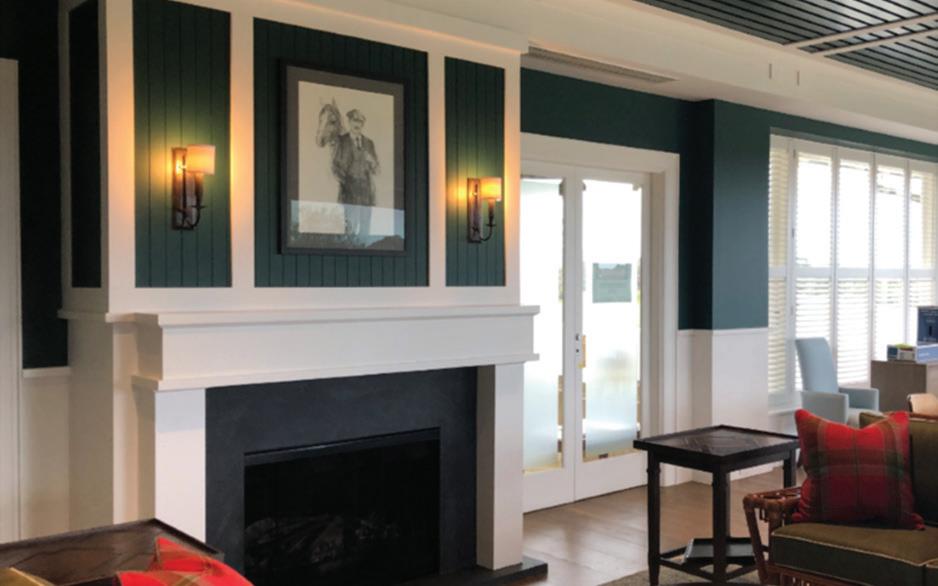


First and foremost, club leaders should be selected based on the following criteria:
» Does their skill set match current club needs?
» Are they individuals of high integrity?
» Do they want the job (too much)?
Clubs are complex enterprises and having leadership that understands the challenges in the various departments is important. It shouldn’t be a popularity contest or based on loyalty to certain groups or individuals.
It is essential that club leaders be of high integrity. There are numerous examples of board members getting club contracts or kickbacks and even ignoring club by-laws to remain on the board for extended periods beyond what is allowed. Many clubs have considerable revenues and budgets and the more money involved, the greater the chances of corruption.
IMHO, the most important criteria for leadership roles at clubs is that anybody who wants the job should be immediately
disqualified. The most effective club leaders are those who are asked, if not begged to lead because of their skill set and high level of integrity.
I’ve always wondered why on earth anyone would want their club to become a job? Isn’t that where we go to relax, play golf or other sports and have fun with friends?
While the volunteering of time and effort is admirable, many do it for the wrong reasons and often seek the power and control involved, just like many of our politicians in Washington. As a result, corruption becomes more likely. Term limits are essential and must be strictly obeyed. It is essential that club leaders develop a productive working relationship with management and staff but that boundaries are established and maintained.
While I agree wholeheartedly with Mr. Dedman that clubs should be run like businesses, there is a difference in that most member-owned private clubs are not-for-profit organizations where decisions
aren’t necessarily made exclusively based on financial impact, but rather member satisfaction.
The bottom line is that if the members are willing to pay for something, and a decision doesn’t impact the long term future of the club, it may be prudent, even if not profitable. The key is whether or not and how the decision impacts the club’s future. Debt doesn’t just go away with the next generation.
It’s just these kinds of decisions where club leadership, club management and independent advisors need to concur on the best path forward and this is best done by all parties “staying in their lane” as defined by their roles.
Published with the kind approval of Larry Hirsh, Golf Property Analysts.
The original article is available on the Golf Property Analysts website: www.golfprop.com

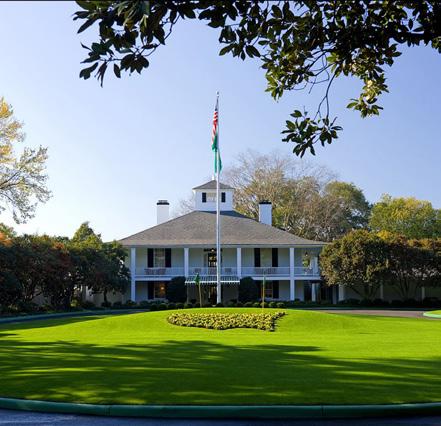






That people transition from casual encounters with golf, like mini-golf or simulators, towards more traditional golf forms like course play and eventually membership may be an attractive narrative, yet is there any evidence that this is the case?
Is there such a thing as a natural “golf pipeline”?
While it’s tempting to think of mini-golf or Top Golf as a gateway to full-course play, the reality is likely far less certain.
GMA's CEO, Paul Vardy , unlocks some of the available industry data and gives his considered assessment.
GMA’s 2023 Member Insights Survey suggests that while alternative golf formats attract new and younger audiences, there's a fair amount of scepticism as to whether this converts to play on public courses or club membership.
Mini-golf draws a young demographic and a high percentage of women; exactly the kind of profile member-based clubs are keen to attract. But, unfortunately, conversion to greater forms of golf and, ultimately, course play and club membership, appears to remain rare. Why?
» Many mini-golf venues operate independently of the broader golf industry;
» Even when located at a golf course, there is limited crossover between mini-golf customers and the course's golfers;
» Mini-golf is more akin to other entertainment options like ten-pin bowling or trampoline parks; it is fun, easy, and comes with low-commitment; However, from a business perspective, it can create more of a community venue with
broader demographics that can deliver a solid return through:
» Low capital and maintenance costs;
» Steady foot traffic from families and casual visitors; and
» Strong hospitality upsides.
Venues like Holey Moley or Birdies Mini Golf Bars aren’t trying to grow golf. Whilst they do align loosely with the golf brand and may play a role in growing community familiarity with the sport, they're ultimately hospitality businesses using a golf theme.
Despite its appeal, especially among 18–34-year-olds and women, mini-golf is still more “entertainment product” than “golf product”.
If we look to the US-based National Golf Foundation (NGF) research (commissioned by Golf Australia in 2021), it gives some clues to the answers:
Key Findings:
» Most beginner golfers follow unguided and transactional journeys, without structured pathways connecting offcourse and on-course forms.
» Facilities like mini-golf and driving ranges generally operate in isolation , rather than as part of an integrated development journey.
Even where a facility has the full spectrum of offerings (like Wembley GC in Perth), it’s unclear whether people naturally “graduate” from one format to the next.
Impact of Off-Course Formats on On-Course Interest:
Increased interest
Format "A lot" "A little"
Mini-Golf 10% 39%
Driving Range 12% 40%
These figures aren’t exactly mind blowing, especially for driving ranges, where participants are arguably much closer to being "golf-ready". But they do indicate a modest level of movement that may be worth exploring.
Interest doesn’t always translate into action. Often, it doesn't even come close. If you look at studies on interest and see whether it actually converts to action, there is most often a wide gulf.
People are aspirational, but often overestimate their availability or motivation.
So, while some mini-golf or simulator players say they’d like to play golf oncourse, very few actually take the next step. This is most likely because of time, cost, being distracted by other choices or lack of clear pathways. I say, observe what they actually do.
According to NGF:
» Beginner course players (those who played on-course for the first time in the past year) made up 16% of all course players;
» Profile: 60/40 male/female split, 68% under age 35, average 5.4 rounds/year;
» Behaviour: In the same year,
• 35% also played mini-golf;
• 37% used a driving range; and
• 21% used simulators.
These are the transitioning golfers. They are the ones who actually crossed over between forms, making this a more meaningful group to understand and target, as opposed to those who state an interest.
Did mini-golf, driving ranges or simulators

cause them to transition, or was this just a correlation? I'm not sure we can know.
NGF defined on-course prospects as people who:
» Are “very or somewhat interested” in oncourse golf; and
» Have the time, money , and motivation to play.
Under that definition, 12.6% of Australians were golf prospects - a surprisingly high figure.
To dig deeper, NGF narrowed this to “best prospects”:
» 3.6% of the population;
» 58% had played before (re-engagement), 54% owned clubs;
» 68% had household incomes over $2,000/week;
» 79% were university educated;
» 60% aged 25–44;
» 63/37 male/female split.
Yet only 14% of these "best prospects" had played any form of off-course golf recently:
» 10% at a driving range;
» 7% at mini-golf; and
» 4% at a simulator
So while off-course formats draw larger numbers, it may not be where the best prospects are actually coming from.
Two key takeaways emerge:
1. There is little evidence of a natural customer journey between forms of golf.
Clubs and facilities aren’t connected in a way that nurtures progression and in reality, most off-course players are not predisposed
to play on a course. Attempts at creating a more structured “golf journey” could be a growth opportunity, but it would require a lot of work to get the right incentives and mechanisms in place between venues. The best golf prospects seemingly aren't engaging in off-course formats in large numbers anyway.
2. The most likely future club members are young, educated, time- and income-rich; and mostly male. This is just the facts.
To diversify, particularly towards more female participation, clubs will need to invest in targeted strategies beyond simply relying on a journey or transition from minigolf or simulators where the numbers are better.
One final, and significant, insight: 89% of players who started on-course golf did so before age 35 :
» 22% started age 12 or under;
» 27% between 13–17;
» 24% between 18–24; and
» 16% from 25–34.
That leaves very few taking it up after 35. Early exposure is critical.
The most common influences in starting golf weren’t coaches or marketing campaigns, but friends and family :
» 38% said friends got them into golf;
» 24% credited parents/family;
» Only 5% said “someone else”; and
» Just 4% credited a coach/instructor.
In short, the most powerful route into golf is through personal connections.
That, more than any product or program, is what drives golf’s future pipeline.

Collaborative governance is the roadmap to success at your private club. That’s because collaborative governance lays down the roles and responsibilities of the club’s board of directors while leaving the day-to-day operation to the club’s general manager/chief operating officer and senior managers.
This means the board establishes the overall direction to ensure the club meets the club’s member experience goals as laid out in the club’s strategic plan. And that’s the way it is for Brett Morris, chief operating officer and general manager, and his president, Joe V. McCart, and board of governors at The Club at Admirals Cove in Jupiter, FL.
“I have worked with numerous boards throughout my career. Some were handsoff and some were very hands-on,” Morris explained recently.
“It’s those early career lessons that have helped me become successful at Admirals Cove. We believe in a collaborative governance model. The board and I discuss strategic planning, our vision and the financial outlook of the club. The board sets the policy and holds my management team and me accountable for the daily operations.”
“The board’s responsibility is to set policy, support the general manager and hold them accountable,” concurred McCart. “In addition, you need a strategic plan with proper financial controls and board oversight.
“An important point: the board’s decisions should be driven by what’s best for the club rather than contemplating what you think the members may say or think. To me, that’s a very poor thought process because the members elected the board to make decisions, not to try and guess what the members may want you to do.
“You must have thick skin as a board member because no matter what decision you make, there will be a certain portion of the membership that will disagree. So make the best decisions you can as a fiduciary to the club and you can find comfort in knowing you acted in the best interest of your club and members,” McCart added.
“Our vision is to provide our members with a world-class membership experience. However, we cannot rest on our laurels. We must always deliver the highest quality of programs, facilities and be up to date with the latest trends in our industry,” Morris said.
“It’s important that the general manager maintains a very open relationship with the board, allowing for open and honest communication, even when you disagree on different approaches. I worked at one club where the average age was significantly older and therefore, they wanted things done a certain way...’ the way they had always done it.’
“However, newer and younger members had fresh ideas and wanted to be innovative and be relevant. They wanted more kids’ activities, restaurants open later and yearround family events.
“We faced the challenge of these younger members not being represented on the board and I had to be their voice. As a GM, you don’t always have to agree with the board, but remember, they are looking for leadership, not ‘yes’ people. The board is looking at you to guide the club. It’s not always rosy, but as long as you have an agreed-upon vision and mutual respect, you will be successful,” Morris opined.
“There are numerous keys to our success at Admirals Cove. First, it’s crucial that, as GM, you have a strong relationship with your club president. I speak to my board president regularly, day and night, and I will tell you he is the most engaged and supportive president with whom I’ve ever worked. I use my board members as my eyes and ears. They give me regular feedback... some of it great news and at other times areas of concern. This data is valuable to make sure we are delivering on our strategic direction and membership experience.”
McCart agreed.
“Brett and I speak daily and often multiple times a day. We have problem-solving meetings and other times just discuss improving or enhancing our members’ experiences.
“A frank and collaborative relationship between the board and management is crucial to success. This has been especially true during the pandemic where we were in uncharted waters. So it was a perfect storm almost immediately after Brett joined management and I was elected to the board and elected president,” McCart added.
“We were hit on multiple fronts – COVID-19 causing the closure of all our facilities, some multiple times because of positive COVID-19 tests among employees, to some dissatisfied members and a general lack of confidence in the board and management.
“Fortunately, after a fairly difficult process and listening to the members’ concerns and addressing the real issues, communicating through various forms, the members responded resoundingly in support of the positive changes from the board and the general manager,” explained McCart, one of BoardRoom’s most outstanding president selections for 2020.
“You cannot internalize the negative comments. You need to be open to constructive criticism and take that feedback and do something about it. You are working for the members and it’s your job to make sure you are delivering on the club’s promise,” Morris injected.
“There is no room for complacency. You cannot wait for a board member to share a complaint; you have to go out and solicit them.”
Morris explained that every six months, the club surveys its members.
“Instead of one long survey that covers every part of our operation, we fragment them so that we get more engagement. So, for example, one survey can focus on golf and our racquet program while another can be devoted to food and beverage and our events.
“Member feedback holds us accountable. We share this information with our board and discuss where we are missing the mark or how my management team and I plan to adjust,” he added.
“Being nimble is crucial to our success. Think about what we all learned during COVID-19. A good crisis plan is one thing but being prepared for a worldwide pandemic is another.
“I knew what we needed to do, and it had to happen quickly. The board and I got together and put in a testing facility on-site for members and staff. We expanded our to-go options, changing menu options weekly; we hosted drive-through events and updated our communication, so everyone was in the loop. Health and safety stayed at the forefront of what we accomplished while having some fun during our season of social distancing,” Morris said.
The average age for members at Admirals Cove is 59. But the club has seen a massive influx of younger families moving in to enjoy the first-class amenities and lifestyle.
“We have nine board members, selected by a nominating committee, who are members in good standing, and that have participated on a club standing committee,” he explained.
“The nominating committee is separate from the board, and the role of the nominating committee is just that – to nominate a person they feel would be a great addition to the board.
At The Club at Admirals Cove, the goal is to nominate well-intentioned members who are not driven by personal agendas. You want people who are interested only in what’s best for the club. I believe having a diversified board is important so that different age groups, areas of interests, etc. are included,” Morris stressed.
It hasn’t always been the case for Morris during his time as a general manager.
“At one club where I worked, there was a member that did not like the food. Her goal was to get on the board and make radical changes to our food and beverage program. But, think about what would have happened if she and her like-minded colleagues got on the board? There would be total disruption and the club would suffer.”
Morris also feels board term limits are important.
“If you have a board member that stays on too long, it can stymie growth. A lack of fresh ideas halts innovation and can affect how you stay relevant and up to date with the latest trends.
“It’s also not healthy to have a board where more than 50 percent of your board turns over yearly. This puts you on a hamster wheel where nothing gets done. If you create a vision or a strategic plan and the new board members disagree, you are back to square one. Staggered term limits help avoid this challenge. I update my board monthly and provide detailed reports on operations and our governance as well as anything else that is pressing. The goal is to make sure every board member is in the know and that we are all on the same page. These updates also strengthen our relationship and help us to work together more cohesively."
The Admirals Cove GM also explained that new board members go through orientations, which introduce them to the club’s governing documents and financial objectives and provide them the guidance to understand their exact responsibilities.
“For example, we want our board members to focus on the big picture, not how much mayo is in the tuna salad. You may think that I’m joking, but have you ever managed a club in Boca Raton, FL?” Morris queried.
Besides orientations, the club also holds annual board retreats. “These are designed to keep the club’s board members aligned with our goals and objectives, review our vision and mission statement and make sure everyone knows what it is they do and the role they play,” Morris explained.
“Communicate with your membership openly, honestly, and in a straightforward manner with no ambiguity. Although it may be uncomfortable at times, I have found it is the best strategy to develop trust with the members as the president and the board. The communications need to be frequent, especially when you’re dealing with significant issues within the club,” McCart stressed.
“During the pandemic, we were unable to meet in person, and we found that Zoom meetings with an open forum for members to participate were particularly effective to have open communications with the general manager and the president. As a result, by sharing specific information and answering the members’ questions in such a straightforward manner, many members were surprised at our candor,” McCart added.
“Governance is different at every club you go to but remember, as a GM, you play a pivotal role in what it looks like and how it’s implemented. So, use your voice and remember why you choose to be a private club general manager,” Morris concluded.
Golf Australia recently announced a partnership with the Australian Institute of Company Directors (AICD) to deliver a dedicated governance education program for golf club leaders and volunteers across the country.
The Golf Australia Club Governance Program, developed in collaboration with AICD, is designed to enhance governance capability and strategic decision-making within golf clubs – supporting the thousands of volunteers who are critical to the success and sustainability of the sport and addressing a key industry concern.
The 2024 Australian Golf Industry Paid Workforce Survey revealed poor board governance and leadership as one of the top reasons people consider leaving the golf industry, while the 2024 Australian Golf Clubs and Facilities Survey highlighted board governance as one of the top areas requiring the greatest improvement in workforce development.
To address this, golf clubs will now be able to benefit from the experience and expertise of the AICD, which is Australia’s leading authority on governance education with more than 35 years of experience and over 63,000 participants in its education programs in 2024 alone.
The first offering of the Golf Australia partnership, Governance Essentials for Golf, is a free, self-paced online course featuring seven concise learning modules. The program is fully contextualised for the golf industry, ensuring that participants gain practical and relevant insights tailored to the unique governance challenges faced by golf clubs.
The estimated more than 11,000 directors currently volunteering their time across golf clubs, facilities and places to play in Australia, equipped with the knowledge, confidence and skills to lead effectively via the new program.
“Volunteers across Australia play an incredibly important role in our game. In recognising this, Golf Australia is looking for ways to support our clubs, and their volunteer administrators, so that golf continues to thrive at every level,” Golf Australia CEO James Sutherland said.
“Whilst participation and membership levels have increased in recent years, there are no shortage of challenges for golf clubs and their boards and committees. Golf deserves

the best in leadership and governance – and this will not only enhance the golfer and member experience, but help futureproof Australian clubs for generations to come.
“We are proud to be working with the Australian Institute of Company Directors to deliver a program that is specifically tailored for golf. Whilst facing unique challenges, the growing interest in golf provides opportunities aplenty and provides good cause for optimism about our sport's future.
“Leadership and governance impacts everyone; whether you’re on a club board or involved in supporting operations on the ground we recommend this program to you and others in leadership roles across our industry.”
Key program outcomes include building foundational governance knowledge across the golf workforce, improving board decision-making and effectiveness, and supporting sustainable growth and stronger outcomes for golf clubs.
This initiative forms part of Golf Australia’s broader commitment to support clubs and facilities through best-practice policies, guidance and leadership development. As part of this partnership, AICD will also provide access to a suite of additional educational opportunities tailored to the golf industry.
To sign up for the Governance Essentials for Golf pilot program, an online course that is free of charge, please visit: www.golf.org.au/ga-club-governanceprogram/
» Over 400 club directors and leaders have expressed interest to complete the Governance Essentials for Golf
» Since the start of June, a number of 1.5 day Governance Foundations for Not-for-profit Directors in Golf courses have been held nationally with more than 150 club directors and leaders undertaking this extended program offering.
» Golf Australia will continue to provide access to Governance Essentials for Golf which is being managed in cohorts during the pilot period, and will be working towards organising other extended program offerings for the industry such as the Role of the Chair course and full Company Directors Course
Clubs based in Regional Victorian Local Government Areas (LGAs) have a unique opportunity to undertake these additional educational opportunities at no cost through support of the Victorian Government’s Department of Sport and Recreation as they continue to roll out their Sustainable Volunteer Workforce Program 2024-2027

Golf Australia has announced the inaugural National Awards of Excellence, a new initiative celebrating the people and places that are inspiring more Australians to play more golf.
For the first time at a national level, Golf Australia will formally recognise the individuals, clubs, facilities and community organisations making a meaningful impact in their community and aligning to the objectives of the Australian Golf Strategy in promoting golf as a sport for all, and for life.
The 2025 National Awards of Excellence will honour achievements across eight categories, including Women & Girls in Golf, Volunteer of the Year, Most Outstanding Club, Facility or Place to Play, along with several participation-based categories such as MyGolf Venue of the Year and Get Into Golf Venue of the Year.
Golf Australia CEO James Sutherland said the introduction of national awards marks an important milestone for the sport.
“Across Australia, so many individuals and organisations are doing extraordinary work to grow the game and create more opportunities for people to play golf,” Sutherland said.
“These awards are about telling those stories, recognising excellence, driving continued improvement and shining a national spotlight on the people and places who are making golf more inclusive, welcoming and sustainable.”
An established initiative for many states and territories, the implementation of the National Awards of Excellence will see state winners automatically nominated as finalists for national honours, and enhance recognition of the excellent work being done around the country.
Additionally, a number of open nomination categories have been introduced to ensure innovative initiatives like environmental leadership, local government partnerships and supplier excellence are recognised on a national stage.
Golf Australia’s General Manager of Clubs,
Facilities and Places to Play, Damien de Bohun, said the awards will also help recognise the contribution of the thousands of people and places that are growing the sport.
“Elevating stories of success – whether from a regional club championing sustainability or a local government creating more access to golf – helps set benchmarks and inspires others,” de Bohun said.
“It’s also a valuable opportunity to build aspiration and recognise the incredible commitment of people and venues that are innovating each and every day, all with the shared purpose of inspiring more Australians to play more golf.”
Award finalists and winners will be announced later in 2025 and showcased via Golf Australia’s online channels.
For more information about the 2025 Golf Australia National Awards of Excellence, including categories and nomination guidelines, visit: www.golf.org.au/ga-national-awards/







Your golf shops visual appeal goes way beyond the products on display.


The colour of your walls, fixtures, fittings and props can create a powerful connection with your customers.






By understanding colour you can create a shopping experience that influences buyer behaviour, enhances customer satisfaction and builds loyalty.




In our strategic golf shop design process, we consider many aspects of your business. What’s selling, what’s not, your store layout and sta e ciency…we even consider colour!
Just ask Kingston Heath , The Brisbane Golf Club and Lake Karrinyup to name a few.

MAXIMISE your Golf Shop Business!


Bold Red: Drive Action and Urgency
When we are planning a Golf Shop Design we keep colour at the forefront of our STRATEGIC thinking.
Colour impacts mood, perception and decision making - it isn’t just about aesthetics. Whether you are renovating your shop or creating a display, di erent colours can evoke emotions and actions.





The right colours can make a BIG di erence in increasing sales via customer engagement, leaving a lasting impression.
W | www.transform.com.au
Sonia Kirkman | +61 419 210 166
Ross Haron | +61 411 601 451




A splash of red can inspire quick decision making. However too much red can be overwhelming so best balanced with neutral tones. Best used for sales signs, window displays and feature areas.
Warm Browns : Create and Grounded, Cozy Feel


Earthen tones such as browns and tans create a warm environment that feel grounded and comfortable. Consider these tones for fixtures, furniture, props and accessories.



Sunny Yellow and Orange: Create Optimism and Energy
Yellow is the colour of happiness and great when you want to convey excitement and energy with orange adding an extra layer of creativity. Use these colours to highlight new arrivals, create welcoming entrances or build seasonal displays.



Refreshing Green: Promote Balance and Well Being
Green is the colour of nature, renewal and balance. In retail, it brings a sense of harmony and makes customers feel comfortable. Green is also synonymous with golf!



Consider using green in seating areas, environmentally friendly product displays, storefront plants and floral arrangements.
Calming Blue : Build Trust and Encourage Exploration

Elegant Neutrals: The Perfect Backdrop



Incorporating shades of blue can make your store feel more serene as it is traditionally associated with trust, calm and stability. Use blue e ectively in customer service areas, fitting rooms or display backdrops.
Neutral tones such as beige, grey and white provides a clean space that allows products and accent colours to shine. Neutral works well for wall colours, fixtures tones or product displays.
Energising Purple: Inspire Creativity and Luxury



Purple is often associated with creativity, luxury and uniqueness. Not commonly used in retail it can make a store feel distinctive. Also adding texture can enhance overall aesthetic.





Use purple to highlight premium products or create unique displays.











Carbrook GC has officially marked the completion of a major restoration and resilience project, hosting an official re-opening ceremony on Thursday, 19th June 2025.
The works were made possible through funding provided under the Community and Recreational Assets Recovery and Resilience Program, a joint government initiative aimed at helping facilities rebuild stronger after natural disasters.
The event brought together representatives from all levels of government, recognising the collaborative effort behind the club’s recovery following the severe 2022 flood event. Queensland Minister for Sport and Racing and Minister for the Olympic and Paralympic Games, the Hon. Tim Mander MP, led the ceremony and unveiled a commemorative plaque now installed at the entrance to the clubhouse.
Joining Minister Mander were Federal Member for Forde Rowan Holzberger MP, who spoke on behalf of the Hon. Kristy McBain MP, Minister for Emergency Management; Logan Mayor Jon Raven;
State Member for Macalister Melissa McMahon MP; and Logan City Councillor Miriam Stemp.
In his address to guests, Carbrook GC general manager Scott Wagstaff recounted the impact of the 2022 floods, which forced the club to close for 30 days due to extensive mud and water damage. “It was heartbreaking,” Wagstaff said, “but we did what Australians do best—we got on with it.”
The more than $1.5 million in government funding has enabled the club not only to restore its facilities but to significantly improve its resilience to future weather events. Wagstaff cited the club’s quick rebound after Cyclone Alfred earlier this year, which saw the club reopen in just 10 days. “From 30 days closed in 2022, to just 10 days in 2025—that speaks volumes about the impact of this investment.”
Wagstaff also acknowledged the contributions of local organisations, staff and community members involved in the restoration process, noting their commitment to the club’s future. “We hope we’ve demonstrated that investment in golf is indeed a worthwhile investment—and

more so, that investment in Carbrook GC is an exceptional one.”
Following the formal proceedings, a number of guests, including Minister Mander, participated in a nine-hole round to see the improvements firsthand.
The newly installed plaque stands as a permanent reminder of the club’s recovery journey and the community effort that made it possible.



platform. This means greater engagement between sessions, more value perceived by members, and stronger levels of retention and satisfaction.
For as long as time itself, the conversation about golf coaching has been left to the PGA Pro, but that narrative is slowly changing.
As golf club managers awareness of coaching and its value grows so too has their support for it, with many clubs seeing improved growth by integrating the coaching experience into their wider operational strategy.
The reason? More effective golf coaching maximises the lifetime value of a golfer and reduces drop-out rates significantly. When golfers play better golf, they play more golf–and that’s good for all levels of a golf club.
During a recent study from Gather, improved playing and spending habits were found when a golfer received coaching from a PGA Pro:
» 30% INCREASED MOTIVATION from golfers when taking lessons.
» $1.75 ANCILLARY SPEND for every $1 spent on coaching.
Good coaching no longer revolves around the quality of instruction alone. Today, world-class coaching considers how sessions are delivered, how efficiently it runs behind the scenes and how valuable it feels to the golfer.
In today’s experience-driven market, coaching is more than a revenue stream for your club—it’s a frontline member service. When coaching looks and feels polished, members notice. And when it’s chaotic or inconsistent, they notice that too.
CoachNow Academy , the coaching management platform now endorsed by the PGA of Australia and rapidly gaining traction among progressive golf club managers, is supporting better coaching and player motivation.
With smart communication tools, automated admin features, and powerful video analysis, CoachNow Academy is not just transforming how golf is taught—it’s elevating the service clubs deliver and the efficiency with which they operate.
Brian Fitzgerald , known as The Golf Doctor, explains it best:
“CoachNow isn’t just about video—it’s about building trust and continuity. I have a full lesson history with each client, and they love having access to their own development archive. It makes my service feel more premium.”
For club managers, this means coaching reflects the professionalism and consistency of the club as a whole—not just the individual coach.
Behind every successful coaching business is a mountain of admin: scheduling, messaging, billing, session logging, content sharing. CoachNow simplifies all of it.
At one club in New South Wales, management introduced CoachNow to standardise lesson delivery across their teaching professionals. The result? A 30% reduction in admin time, smoother handovers between coaches, and zero lost records.
» Integrated scheduling and billing reduce friction for both coach and client.
» Templates and post scheduling allow coaches to build repeatable programs and automate content drops.
» Smart lists and group controls streamline communication across clinics, teams, and member categories.
» Up to 300GB of cloud storage makes content libraries accessible, secure, and scalable.
This level of efficiency doesn’t just benefit coaches—it’s a competitive advantage for club managers, giving you more control, more oversight, and the ability to grow the coaching arm of your operation without additional headcount.
From high-performance programs to beginner clinics, CoachNow ensures members stay connected and progressing— even between lessons. Video feedback, voice notes, training plans, and coach checkins can all be delivered remotely via the
One Queensland-based club saw retention in its junior academy jump after introducing CoachNow. Parents reported feeling more informed and involved, while students appreciated having videos and drills they could review at home. For the club, it was a tangible lift in both perceived value and program loyalty.
CoachNow’s official appointment as Coaching Software Supplier to the PGA of Australia further underscores its value to the coaching profession. As Geoff Stewart, GM of Membership and Education at the PGA, noted:
“CoachNow not only provides enhanced value to PGA Members but also assists us with the development of future coaches.”
The offer to PGA Members provides free trial access and 25% off all plans after the trial period.
Ultimately, CoachNow allows golf clubs to run better coaching businesses and deliver a superior member service—with no compromise between quality and efficiency.
For managers, this is more than a tech upgrade…it’s an important investment into your wider operational strategy. One that enhances your brand, supports your coaching staff, and delivers real value to members.
An investment into golf coaching is not just an investment into somebody’s golf game— it’s an investment into a healthier and more engaged membership.
To learn more or to activate your PGA Australia member offer, visit: coachnow.io/pgaa-benefit or email: apac@golfgenius.com
In today’s digital age, cyber security isn’t just an IT issue, it’s a boardroom priority.
For Australian directors, the responsibility to safeguard their club from cyber threats is not optional: it’s enshrined in law.
Directors are expected to approach cyber governance with the same rigour as financial oversight.
This means understanding the unique cyber risks your club faces, aligning those with business strategy, and embedding cyber resilience into every layer of decisionmaking.
A director’s duty of care now extends into cyberspace and the stakes have never been higher.
Instances of hackers gaining access to club data is becoming more common. Hackers are after money, and the easiest way to gain that quickly is to hack a database with personal information, ransom it back to the club it was stolen from and sell off the data list anyway. Accessing your database is lucrative.
Jason Drew, CEO of Secom Technology Group, has developed a new Cyber Security Division, Security Interactive, to help clubs proactively manage their system security and third-party integrations. Based in Australia, Security Interactive specialises in:
» Cyber Security incident response, remediation and reporting
» Network Security vulnerability scanning and penetration testing
» Third party vendor security management and infrastructure design
» Implementation of ASIC recommended Cyber Security standards - Essential 8

» Advanced Office 365 Security implementation and SOC monitoring. Find out more about how a Security Interactive

First Choice Services (FCS), a national facilities management company, provides comprehensive cleaning and maintenance services across a range of sectors such as retail, hospitality, healthcare and wellness.
Among these, there is a passion for the golf industry. With a strong understanding of the operational challenges and presentation standards unique to golf clubs, First Choice Services continues to expand its presence in this space.
In March, FCS commenced services at Twin Waters GC on the Sunshine Coast. Working alongside the team has been a valuable opportunity to support a club with a welcoming atmosphere and high member expectations—aligning well with First Choice’s service standards and peoplefocused approach.
In June, the company commenced cleaning services at Beverley Park GC located in South Sydney. The FCS team has been working to ensure services are delivered effectively and integrate smoothly into the day-to-day operations of the venue.
That same month, FCS signed on with Royal Melbourne GC for a preventative HVAC Maintenance Program, designed to keep all heating, ventilation and air conditioning systems running efficiently and maintained at optimum operating conditions.
The company’s service extend to a full suite of facilities support—from repairs and trade services to consumables and preventative maintenance. By offering an integrated solution, FCS enables its clients to streamline operations through a single trusted provider. The result is not just convenience, but improved efficiency and peace of mind for managers seeking reliable, professional support across all touchpoints.

Beyond operations, FCS is committed to contributing positively to the wider community. On Friday, 20th June, the company proudly hosted and sponsored the Destiny Rescue Sports Lovers Luncheon on the Gold Coast for the fourth year. Destiny Rescue is an organisation doing incredible work to rescue children from human trafficking and exploitation. It’s confronting, life-changing work—and something FCS is proud to stand behind. Every child deserves safety, freedom and a future. Destiny Rescue is helping make that possible.
Speaking at the event, David High, National Sales Manager for FCS, shared “It’s always an amazing day, and it’s so warming to see everyone come together for such an incredible cause. The support we’ve seen is inspiring, and we’re proud to be part of it.”
As FCS continues to grow its footprint across the golf and sporting club sector, the company remains focused on building meaningful partnerships, delivering consistent service, and supporting the people and communities that make this industry so unique.
We all

Club Car, a global leader in golf cars, low-speed utility vehicles and personal-use transportation, has announced the appointment of Craig Scanlon as President and Chief Executive Officer.
Scanlon succeeds Mark Wagner, who announced his retirement in March.
With over two decades of executive leadership experience, Scanlon has held key officer roles in both private equityowned and Fortune 500 organizations, most recently as CEO of K&N Engineering. His career spans the industrial, powersports and automotive aftermarket sectors, including 18 years at Polaris where he rose to the role of Chief Marketing Officer.
Scanlon's career began in 1998 in commercial sales of Club Car Carryall vehicles at Ingersoll Rand.
“Craig is a proven leader with an impressive combination of operational expertise and
deep industry experience. His success driving growth and innovation makes him the ideal choice to lead the next chapter at Club Car,” said Jared Hutchins, Principal at Platinum Equity, which acquired Club Car from Ingersoll Rand in 2021.
“I’m honored to return to Club Car at such a pivotal time,” said Scanlon. “The usage of low-speed vehicles is evolving, and I look forward to leveraging Club Car’s rich history and brand while embracing innovation that serves our channel partners and customers.”
Club Car is poised to rapidly innovate with upcoming initiatives focused on new product and features, technology, and digital connectivity, continuing its commitment to deliver a best-in-class experience for its customers.
For more information on the products and services from Club Car, visit their website: www.clubcar.com


To assist us in better informing and educating our members, we would like your assistance to continue providing relevant, interesting and unique stories from within the golf management industry that we can share in this journal. If you would like to write a piece for the GMA Journal, we’d certainly love to hear from you.
Please send your material to our Media & Communications manager, David Branddavid.brand@golfmanagement.com.au.

